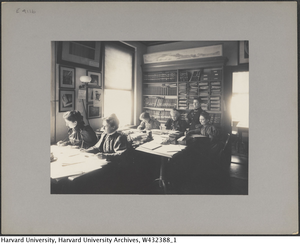
Added to collection: 2016/02/25
Earliest source: "[Observatory data analysis by women computers] ." Harvard University Archives / UAV 630.271 (E4116). Harvard Libraries, olvwork432388
Women computers working (or posing as if they're working) in a room in the new brick building, built in 1892.
I've dated this photo to March of 1898 based on a calendar visible in the image. The year is not actually legible, but it's a year in which the first was a Tuesday. It also appears (not very clearly) as if the calendar is marked with quarter moon phases, and based on this interpretation, it can only be 1898.
Williamina Fleming is standing. Immediatly in front of her are Eve Leland (back row center) and Ida Woods to the right. The rest are unidentified, although the woman closest to the camera could be A. J. Cannon.
Note: Harvard identifies this as a photo including Henrietta Leavitt. She does not appear in this photo.
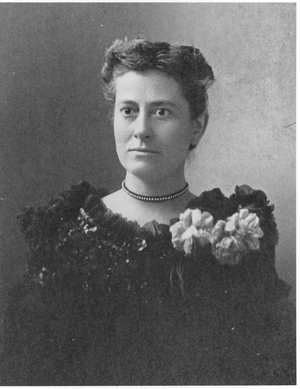
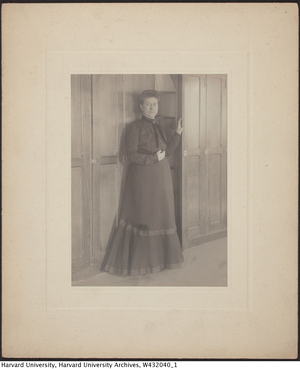
Added to collection: 2016/02/18
Earliest source: "[Williamina Fleming at Harvard College Observatory plate stacks, ca. 1900]." Harvard University Archives / UAV 630.271 (388). Harvard Libraries, olvwork432040
Williamina Fleming at Harvard College Observatory plate stacks. These are the "new" plate stacks in the brick building addition, built in 1902.

Added to collection: 2016/02/18
Computers in one of the computing rooms at the Observatory. Harvard's date of 1891 for this photo is probably pretty accurate. It has to be after Dec. 1889, based on the graph on the wall of β Aurigӕ, just behind Antonia Maury (who is credited for discovering that it is a binary star). And as it was published in an April 1892 New England Magazine, thta's the upper limit on the photo.
This is the same location as the photos with Mrs. Draper and some of the computers, the larger computing room on the top floor of the west wing of the Observatory.
From left to right:
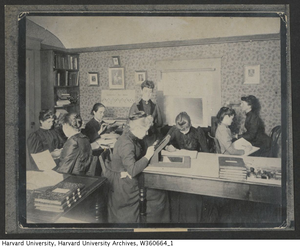
Earliest source: "A group of women computers [photographic group portrait, ca. 1900]." Harvard University Archives / HUPSF Observatory (45). Harvard Libraries, olvwork360664
A group of women computers [photographic group portrait, ca. 1900]
ca. 1900

Added to collection: 2016/02/18
Earliest source: "[Observatory computer room and staff], 1891." Harvard University Archives / HUV 1210 (9-4). Harvard Libraries, olvwork289689
Nearly the identical photo as the previous, but with Pickering added standing on the left. Obviously taken the same day.
Note that the women did not work this closely. As can be seen in the above photos with Mrs. Draper, the room is larger and they are crowded together for sake of the photograph. There were between three and five rooms total for the computing work, and by my best guess about 15 women worked there at that time, as well as at least five men. Still cramped, but not this cramped.
The following year, a brick building was constructed to help out with the space issues.

Added to collection: 2016/02/18
Earliest source: "Observatory [analysis of stellar spectra], 1891." Harvard University Archives / HUV 1210 (9-6). Harvard Libraries, olvwork289693
Date is from Harvard
I think this is Williamina Fleming, seated on the right. The woman on the left may be Mabel C. Stevens, and she's wearing the same dress as one of the women of women computers in the old building with Fleming. Fleming appears to be wearing the same dress also, but without the jacket.
This photo was taken on the same floor as that other photo, but in a the other computer room at the oppisite side of the building.
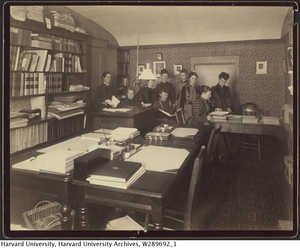
Added to collection: 2016/02/18
Earliest source: "Observatory girls with Mrs. Draper, 1891
Alternate Title: [Observatory computer room and staff], 1891." Harvard University Archives / HUV 1210 (9-5). Harvard Libraries, olvwork289692
Another photograph taken in the same place and on the same day as the previous, with the same people.

Added to collection: 2016/02/18
Earliest source: "[Observatory women computers], 1891." Harvard University Archives / HUV 1210 (9-3). Harvard Libraries, olvwork289691
A group photo of computers at Harvard together with Mary Anna Palmer Draper, aka Mrs. Henry Draper. She's seated in the middle. After her husband's death, she contributed a significant sum of money to continue her late husbands' dream of scientific astrophotograpy, leading to the Draper Catalog, an ambitious project of the Observatory. Many, though not all, computers were funded for this project.
Harvard dates this as 1891. It seems to be approximately the same time as other photos with similar groups of women, taken in the same room. I think there were two pairs of photos taken on different days.
The photo was taken in the long computing room (see 1876 floor plans) on the south side of the second floor (the top floor, excluding the dome) of the building. The photograph was taken facing east, and the doorway in the photo is the closet shown in the floor plan.
Left to right:
Note that Stevens is Mrs. Fleming's maiden name, and she did have other relatives in Boston, but so far I don't know if any of the other Stevens that worked at the Observatary are related.
[Observatory women computers], 1891
1891
General: The women depicted in this photograph analyized stellar photographs and computed data at the Harvard College Observatory.
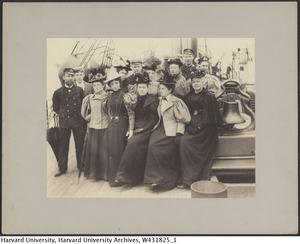
Added to collection: 2016/02/18
Earliest source: "[Women on-board ship, ca. 1900]." Harvard University Archives / UAV 630.271 (173). Harvard Libraries, olvwork431825
A group of women, most or all computers from the Observatory, on board the C.S. Minia, a cable repair ship. On the early end for possible dates of this picture, Mabel Gill (holding Fleming's hand) was hired in 1892 (assuming she had been hired at this point). At the other end, Fleming passed away in 1911.
The Minia became famous as one of two ships primarily responsible for picking up survivors (and bodies) after the sinking of the Titanic in 1912. Before that, the Minia was a well-known ship under Captain Trott, also well-known for his ability to find and repair broken transatlantic telegram cables, in the deepest seas and the worst weather. He was also known for his hospitality when in port, and this photo could simply have been an opportunity to visit the ship, although he is not one of the gentlemen in this picture.
William Squares DeCarteret took over as captain in 1899 after Trott passed away, and James Adams became his chief officer. In her 1900 journal, Williamina Fleming specifically mentions a letter from "Captain Adams" about the Minia. James Adams did eventually become captain of the Minia but it seems to be at a later date. At any rate, Miss Fleming apparently had some direct connection with an officer on the ship.
Another possible connection would be the Observatory's early interest in telegraphy; they might have had much more direct contact with the ship than your average telegraph customer. Transatlantic cables were used for clock synchronization and precise longitude determinations from the very beginning. In 1873, Joseph Lovering published On the Determination of Transatlantic Longitudes by Means of the Telegraphic Cables.
Also, Captain Trott and at least one crewman were members of the Nova Scotia Institute of Science, which sent their proceedings to the Observatory, so it's possible there were other connections between this ship and the Observatory also.
Left to right:
*I found photos of both captain De Carteret and Adams, and I think it's at least possible that these men are those men, but I may have them reversed as they look like brothers to me.
**I think it looks more like Cannon, and I want it to be her because I actually have no other images (besides very large group shots at conferences) with Fleming and Cannon together. BUT, reasonable estimates of this photo's date would put Cannon in the 35 to 40 range. If this is her she certainly looks MUCH younger than the 1902 photo I have of her.

Earliest source: "[Williamina P. Fleming, photographic portrait, ca. 1890]
Alternate Title: [Fleming, Williamina P., [photographic portrait, ca. 1900]." Harvard University Archives / HUP Fleming, Williamina (1). Harvard Libraries, olvwork289681
[Williamina P. Fleming, photographic portrait, ca. 1890]
Alternate Title: [Fleming, Williamina P., [photographic portrait, ca. 1900]
ca. 1890
Historical: Williamina Fleming worked at the Harvard College Observatory. She analyized stellar photographs and computed data.
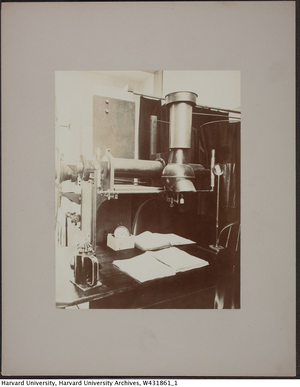
Added to collection: 2016/02/16
Earliest source: "[Apparatus]." Harvard University Archives / UAV 630.271 (209). Harvard Libraries, olvwork431861
[Apparatus]
ca. 1910-1930
Creator: Harvard College Observatory, Cambridge
This photograph matches an engraving used as the frontispiece in Annals volume 14.annals14, where it is referred to as "General View of Meridian Photometer". This measures the brightness of stars, by comparing any given (relatively northern) star next to the North Star, allowing you to adjust the brightness of either star until the match, and measure the ammount of dimming required for that match. This was a completley independent device, unlike most other photometers used by Harvard, which were complicated eyepieces for existing telescopes.
The Observatory went on to build at least two other Meridian Photometers, a four inch model used from about 1882 to 1890, and a twelve inch used extensively after that.
The object on the near left corner of the table is a boat signal lamp, a lantern with a lens on one side. Or in modern terms, a flashlight.
This device is the leading contender for "Photometer P" from Observatory Pinafore.
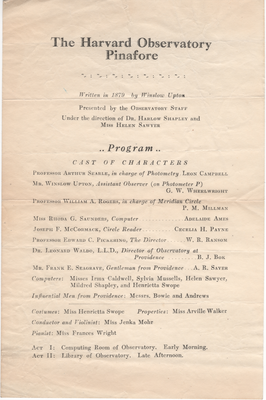
Added to collection: 2016/02/10
The Program for the Observatory Pinafore
The script of this play with annotations is available, although it is a work in progress.
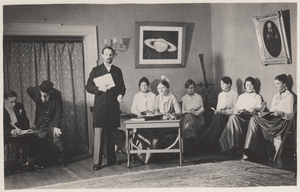
Added to collection: 2016/02/10
A scene from Observatory Pinfore, with Astronomers and Computers hard at work. Based on the people (and the books), this may be somewhere in the first scene of the play. If so, this could be the Winslow Upton character standing, as the right set of people are on stage for Upton's reciting of "I know the value of a kindly chorus..."
The portrait of Galileo hanging on the right still hangs in the Observatory today; it is the copy by Carlton gifted in 1890.
Identifications
Use/Copyright: Copyright held by Charles Reynes, used here with permission
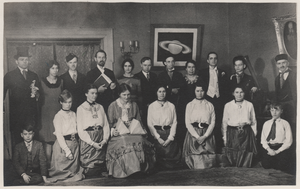
Added to collection: 2016/02/10
The Cast and Crew of the Observatory Pinafore
A set of six photos of the Observatory Pinfore has recently turned up. They've been scanned by their owner, Charles Reynes, who's the great grandson of Edward Skinner King (who was almost certainly at the performance - he's in the group photo for the AAS conference where the play was staged). They are by far the best quality images I've found anywhere of the performance, and three of them haven't been found anywhere else.
I'm having a particular problem with two identifications from these photographs: G. W. Wheelwright as Winslow Upton and W. R. Ransom as Pickering. I'm hoping to identify the characters from the context of the photos, but at this point I'm not sure that will work. From the opposite end, I've attempted to find photographs of both Wheelwright and Ransom in other contexts. Neither seems to look at all like the character in the photos with the more recessed chin.
Identifications:
Bart J. Bok, unknown women, unknown man, [Wheelwright or Ransom], unknown woman, Harlow Shapley, [Ransom or Wheelwright], Arville Walker, Peter M. Millman, Arthur R. Sayer, Leon Campbell
unknown boy, Mildred Shapley, Adelaide Ames, Cecilia Payne (Gaposchkin), Henrietta Swope, Sylvia Mussels (Lindsay), Helen Sawyer (Hogg), unknown boy
Use/Copyright: Copyright held by Charles Reynes, used here with permission
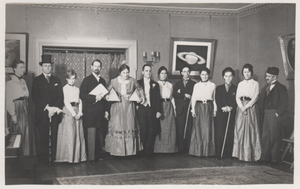
Added to collection: 2016/02/10
The cast of the Observatory Pinafore
Identifications:
Adelaide Ames (as Rhoda G. Saunders), Bart J. Bok (as Leonard Waldo), Mildred Shapley (as computer), Unknown, Cecilia Payne (as Josephina McCormack), Peter M. Millman (as William Augustus Rogers), Henrietta Swope (as computer), Unknown, Helen Sawyer (as computer), Arthur R. Sayer (as F. E. Seagrave), Sylvia Mussels (as computer), Leon Campbell (as Arthur Searle).
Use/Copyright: Copyright held by Charles Reynes, used here with permission

Added to collection: 2016/02/10
A scene from the Observatory Pinafore performance, perhaps dancing.
Identifications
Bart J. Bok, Adelaide Ames, Unknown, Leon Campbell, Cecilia Payne, Peter Millman
Use/Copyright: Copyright held by Charles Reynes, used here with permission
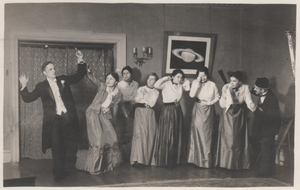
Added to collection: 2016/02/10
A scene in Observatory Pinafore, where Josephina stops Professor Rogers from killing himself in despair over the defection of his helpful assistant, and circle reader, and whatever else.
This image is the most widely available image of the performance.
Identifications:
Peter Millman, Cecilia Payne-Gaposchkin, Henrietta Swope, Mildred Shapley (daughter of Harlow and Martha Shapeley), Helen Sawyer-Hogg, Sylvia Mussells-Lindsay, Adelaide Ames, Leon Campbell.
These identifications come from the copy of this picture in the Emilo Segre Visual Archive. I've based some of my own identifcations on this list. This is my only source for Mildred Shapley and Sylvia Mussels, all the other faces I've found in other photos (to varying degrees of a satisfactory match, but at least enough of a match to improve my confidence that they're correct).
Use/Copyright: Copyright held by Charles Reynes, used here with permission

Added to collection: 2016/02/10
A scene from the Observatory Pinafore where Josephina is being pulled away from Professor Rogers by Seagrave and the men of Providence.
I believe this is the point in the play where Josephina is led to the "dungeon".
Identifications:
Unknown, Bart J. Bok, Unknown, Arthur Sayer, Cecilia Payne, Henrietta Swope, Mildred Shapley, Helen Sawyer, Sylvia Mussels, Adelaide Ames.
Use/Copyright: Copyright held by Charles Reynes, used here with permission
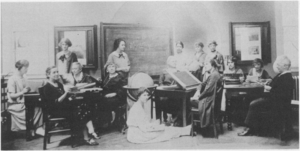
Added to collection: 2015/09/11
Earliest source: Margaret W. Rossiter. ""Women's Work" in Science, 1880-1910." Isis vol. 71 no. 3. University of Chicago Press, September 1980.womensworksci
Unknown location. (Actually I now believe this may be the west wing of the original building, in the transit room, but after the transit instruments were removed). Source says this photo was taken 19 May, 1925.pickeringsharem
I've only just now noticed that these women are all wearing the exact same outfits as in the other 1925 photo above "As We Were", and so both photos were probably taken on the same day. They appear to be the same set of women, and based on that I've put in the five names I hadn't figured out.
My guesses on identity, left to right:
H. Wilson, A. Maury, A. Hoovens, I. Woods, A. J. Cannon, M. Howe, M. Harwood (on floor), E. Leland, A. Walker, L. Hodgdon, C. Payne (seated), E. F. Gill (standing), M. Walton Mayall, M. Gill, F. Cushman
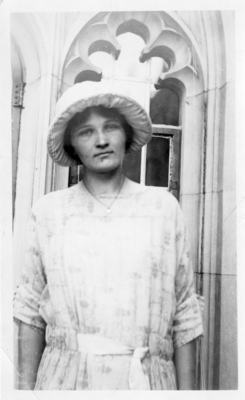
Added to collection: 2015/08/26
Earliest source: "Cecilia Helena Payne Gaposchkin (1900-1979)." Smithsonian Institution Archives. 26 [retrieved] August 2015.sia2009-1328
I have no information on when or where these photos were taken (but I did learn about foil traceries and cinquefoil arches). But she seems fairly young, so I'd guess close to the same time as her doctoral thesis.
So about that thesis. The way the story is conventionally told, Ms. Payne discovered that the Sun was mostly made of hydrogen and helium, but THE MAN (Henry Norris Russell) wouldn't let her announce those results. Allegedly because of him she published her hydrogen and helium results as "almost certainly not real". While she did use that quote, the evidence for the rest is lacking - no letters [edit- actually there is one, although there are context issues], no early copy of her thesis. And most importantly she doesn't mention it in her autobiography, even though she is vaguely critical of Russell for other reasons (though overall she respected him deeply as a mentor).
Here's the story as I would tell it (danger - we're venturing strongly into opinion territory). Cecilia Payne published a revolutionary thesis in 1925 called Stellar Atmospheres. What she did was both ground-breaking, and fundamental to all stellar astrophysics that followed. Spectrum analysis was very important in astronomy because it could tell you what stars are made of. But until Cecilia Payne's thesis, what it couldn't do was tell you how much of each element was in the stars. Payne applied new theoretical models in quantum mechanics to the analysis of spectrums to estimate how much of each element was in the stars.
She applied this method, and published the results. And the results show that, wow, stars are almost entirely hydrogen and helium. So why did she say "almost certainly not real" if not for THE MAN? The understanding of science in those days was that everything in the universe was made of the same stuff, which is to say, just like the earth. And up until Payne's thesis, stellar spectra confirmed this - stars were made of the same stuff as the earth. And in fact, setting aside the hydrogen and helium, the rest of Payne's results confirmed this prevailing view - the ratios of elements in the stars matched pretty well with what was on the earth.
So pretend you are a scientist, a real scientist who's work is accepted by and respected by your peers. And you discover something completely unexpected and unexplained. Do you shout a complete change in orthodoxy from the rooftops, or do you publish a very cautious note about your unexpected result? If anything, Payne was brave to include the unexpected results at all, even with the "not real" notation, as there have certainly been other scientists who've simply left out unexpected data points.
This then, is why I don't like the conventional retelling. It belittles Ms. Payne's role of a responsible, professional scientist, simply to make an inappropriate point about THE MAN. If Russell did advise her to add that note, it was good advice, but I prefer to think that she was smart enough and professional enough to have published her results this way anyway.
Also, it encourages us to think of all past men as neanderthals, rather than living, breathing individuals. While sexism in general was certainly much worse then, the astronomical community was an exception, generally accepting of women as respected contributers (no doubt in part because of the legacy of Pickering's women computers). And within that community she'd found an even rarer exception at Harvard Observatory, with a small group of men and women who were actually encouraging women to advance as equals.
[But read part II in the next picture]
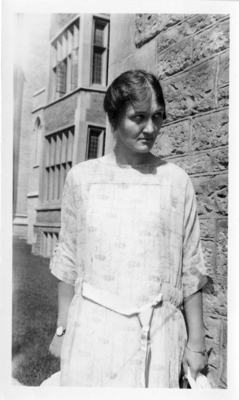
Added to collection: 2015/08/26
Earliest source: "Cecilia Helena Payne Gaposchkin (1900-1979)." Smithsonian Institution Archives. 26 [retrieved] August 2015.sia2009-1327
[continuing opinions from previous picture]
Of course, having said all that great stuff in defense of men of that era, it was only a small bubble she was in. All the friction outside that bubble held her and all women back. Let's look at THE MAN from that story. Her Mentor, Henry Norris Russell, was not at Harvard, but rather at Princeton. Russell credits his math skills to his mother and grandmother, and he also helped Annie Jump Cannon get one of her honorary degrees, so really not THE MAN he's supposed to be in the popular narrative. But Russell sent his own promising grad student to study at Harvard, Donald Menzel. He did this for the same reason everybody did research at Harvard - their amazing collection of astrophotography and spectra. But in some sense, this also put Menzel in competition with Payne as they were doing very similar research. To avoid trouble Payne's advisor (and director of the Observatory), Harlow Shapley, split up the data (I don't remember exactly how). This was for Payne and that was for Menzel.
In a telling turn, and one that resonates with lessons today about men and women competing in the modern world, Payne kept her crayons inside of her lines, but Menzel did not. He studied all the available data. Who made the right choice? I'm not sure, and I think in this particular case it didn't matter terribly much (she published an amazing thesis). However in the long run, Menzel also ended up back at Harvard, and was a director of the Observatory, a position that Payne was never able to attain. But in my opinion this almost certainly had more to do with sexism at Harvard than it did with research choices they made as grad students.
Ultimately as great as Shapley and Russell and others were for her career, there was little they could do to overcome the deeply rooted sexism in the wider world. Nor should I overstate the acceptance within the astronomical community itself. It may have been ahead of the rest of the world, but people are always products of their times. Sexism was inescapable.
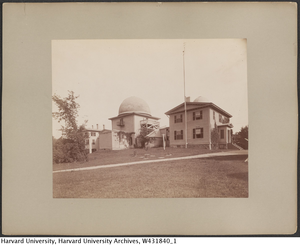
Added to collection: 2015/08/25
Earliest source: "[Harvard College Observatory buildings in Cambridge]." Harvard University Archives / UAV 630.271 (188). Harvard Libraries, olvwork431840
The Sears Tower and the west wing with the west equatorial dome. Before the brick building. After Sears Tower balconies were replaced with wooden ones in 1880 or 81. Based on the small plants in the foreground and the vine growth on the buildings, I put this just after another photo that also shows these features, as well as a completed dome for the 11-inch refractor, not visible here.
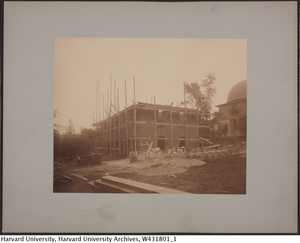
Added to collection: 2015/08/25
Earliest source: "[Harvard College Observatory building under contruction] 1892." Harvard University Archives / UAV 630.271 (149). Harvard Libraries, olvwork431801
[Harvard College Observatory building under contruction] 1892
1892
Creator: Harvard College Observatory, Cambridge
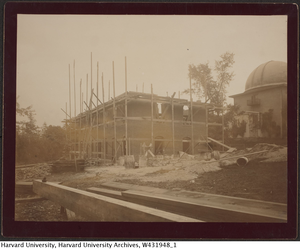
Added to collection: 2015/08/25
Earliest source: "[Harvard College Observatory, Cambridge, construction, ca. 1892]." Harvard University Archives / UAV 630.271 (296). Harvard Libraries, olvwork431948
[Harvard College Observatory, Cambridge, construction, ca. 1892]
1892
Creator: Harvard College Observatory, Cambridge

Added to collection: 2015/08/25
Earliest source: "[Harvard College Observatory, Cambridge, construction, ca. 1892]." Harvard University Archives / UAV 630.271 (294). Harvard Libraries, olvwork431946
[Harvard College Observatory, Cambridge, construction, ca. 1892]
1892
Creator: Harvard College Observatory, Cambridge
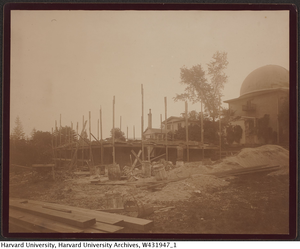
Added to collection: 2015/08/25
Earliest source: "[Harvard College Observatory, Cambridge, construction, ca. 1892]." Harvard University Archives / UAV 630.271 (295). Harvard Libraries, olvwork431947
[Harvard College Observatory, Cambridge, construction, ca. 1892]
1892
Creator: Harvard College Observatory, Cambridge
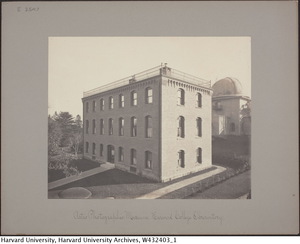
Added to collection: 2015/08/25
Earliest source: "Astro Photographic Museum. Harvard College Observatory [(i.e. C building)] ." Harvard University Archives / UAV 630.271 (E2547). Harvard Libraries, olvwork432403
Astro Photographic Museum, aka Brick Building, aka Building C (in later years).
This building was completed in 1892. The look of fresh landscaping makes me think this could be early 1893 (but after the transfer of plates in the snowy photo). It has to be after the plate transfer, which shows no railing around the top, while this image has the railing (but no later than 1902 when the addition was built).
This photo looks more professional than many. It was taken from a perfect height to render all the vertical lines perfectly parallel, and the image is so clean that at small scale it looks like an artists' concept drawing.
ca. 1890-ca. 1920
Creator: Harvard College Observatory, Cambridge

Added to collection: 2015/08/24
Earliest source: "[View of Harvard College Observatory in winter, photgraph] ." Harvard University Archives / UAV 630.271 (E2434). Harvard Libraries, olvwork432391
At first I just loved this as a very unusual angle compared to anything else I've found, and because it shows a bridge connecting to the brick building that I haven't seen elsewhere. Then I realized it might be a lot more significant.
Take a close look to the right of the center of the image - there appears to be a box hanging from a rope strung between buildings, in front of the windows of the distant building.
According to the Director's annual report of 1893:
"On March 2, 1893, a transfer was made of a large portion of the contents of the west wing of the main building of the Observatory to the new brick building. Nearly thirty thousand glass photographic plates were transferred from one building to the other without serious accident. The greater number of plates measured eight by ten incnes and the total weight of the glass was about eight tons. A rope was stretched from the old building to the new, and boxes each containing one hundred plates were attached to a pulley and allowed to run down. They were thus transferred at the rate of about six thoudand an hour."annual1893
So it's possible this is them transferring other items (like the Phillips library contents) on ropes, on some other day. But it seems like there's a fair chance this is a photograph of the events of March 3, 1893. A preliminary check does show that they had a very snow February that year (at least Worcester did).
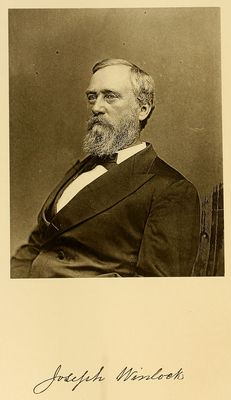
Added to collection: 2015/08/21
Earliest source: F. O. Vaille and H. A. Clark (Class of 1874). The Harvard Book / A Series of Historical, Biographical, and Descriptive Sketches vol. 1. Welch, Bigelow, and Company, 1875.harvardbook
Joseph Winlock was the third director of the Harvard Observatory, taking over after George Phillips Bond passed away in 1865. Winlock would only serve a decade until his own death, around the time this book was published.
Winlock was the grandson of a revolutionary war soldier, General Joseph Winlock (starting as a private; Captain by the end of the war). Raised on a farm in Kentucky, he graduated from Shelby College, where he was given an appointment as professor of Mathematics and Astronomy. He moved from there to working as a computer in Cambridge for the American Ephemeris and Nautical Almanac. After several more job changes and advancements, he wound up at the Observtory, where he took over as director.academywinlock
Under Winlock, the Observatory sold accurate time data to various customers, in part based on improvements to the instruments made by Winlock. In appreciation for this, Harvard provided his family with a stipend of the proceeds from this service for five years. Perhaps it was not enough, or perhaps she just wanted to follow in her father's footsteps, because his daughter Anna felt the need to ask the Observatory for a job as a computer, and thus became the first woman hired for this work at the Observatory (as far as anyone knows), eventually joined by her sister Louisa.
I don't know when the photograph was taken, but given that all the photographs in the book seem to be in the same style, I think it's ok to assume they were all taken in preparation for this book, which was begun by the class of 1874 in their final year.harvardbook

Earliest source: "William Cranch Bond / American Astronomer." Encyclopædia Britannica. 21 [retrieved] August 2015.bondbritannica
Very low quality image, but it suggests a possible alternative source of the photograph of Bond, as this does not seem to me to derive from the printing in Annals 7. It gives me hope that I might track down a better quality photo of him, however I haven't found this anywhere besides Britannica yet.
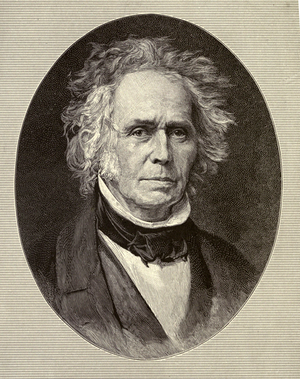
Earliest source: William Jay Youmans. Pioneers of Science in America / Sketches of their Lives and Scientific Work. D. Appleton and Company, 1896.scipioneers
A very good quality engraving based on the photo in Annals 7. This source says it is based on an "engraving" from Annals, but that's clearly not the case.
To my eye, they've enhanced his hair a bit. His head also seems slightly less tilted but I think the entire portrait is just rotated.

Added to collection: 2015/08/19
Oh the irony.
The second director of the Observatory, taking over after his father's death in 1859, George Phillips Bond will serve as director for only six years, until his own death. He is considered the father of astrophotography, dedicating his short career to progress in this area. He and his father assisted John Whipple in his famous photographs of the moon, and it was George who brought them to Europe, where they were instantly famous. The heavily photographic programs of future directors Winlock and Pickering (with all the women computers doing the grunt work) will be built on foundations created by George Phillips Bond.
And despite all this, there are no known photographs of him at all, nor any portraits of any kind.
All we have is descriptions. His daughter Elizabeth offers hers:
"In person he was rather tall (a little under six feet) and slender, becoming, of later yearsm painfully thin. His hair was wavy and very dark, if not black; his complexion pale, and his eyes of the deepest blue, with a glowing spiritual light in them that transfigured the worn face, lending it a singular power and beauty quite apart from mere regularity of feature."bondmemorials
He was not the son destined to follow in his father's footsteps. His younger brother, William Cranch Bond Jr. was an avid astronmer and seen by some as the bright hope for the future of the Observatory. But he died at the end of his college career. Older brother George assumed the mantle of astronomy "with some reluctance" as a friend describes. George's first and greatest love was ornithology.bondmemorials
As if having no portraits isn't enough of a slight, it's also hard to find him now. Some online sources say he is buried at Mount Auburn Cemetery as is his father. But he's not in the Mount Auburn Database. So I had a look for myself. The family Bond monument has many names carved in it. George's name and other details are carved into the back, behind the bushes. But it turns out that many family names have been added to W. C. Bond's monument, though they are interred elsewhere. After contacting Mount Auburn Cemetery, they were able to tell me that George is interred in Cambridge Cemetery, lot 305.

Added to collection: 2015/08/19
Image Credit: Cephas Thompson
Earliest source: "William Cranch Bond (1789-1859)." Harvard Portrait/Clock Collections. Harvard Libraries, HUAM311225
Creator: Thompson, Cephas Giovanni (1809-1888), American
Signature: signed on verso: Cephas G. Thompson 1849
Credit Line: Harvard University Portrait Collection, acquired before 1877
I assume this is just a different (more blurry) photo of the same painting by Cephas Thompson as the other image I have, but the quality is different enough that I can't be completely sure that these are not two different copies of the same painting (by the same artist). While the resolution is a little lower, this photo includes more of the edges of the painting.
This painting currently hangs in the main lobby of the Observatory, along with paintings of most of the other directors..
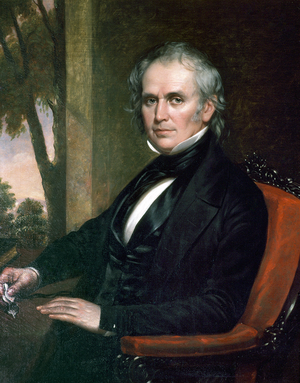
Added to collection: 2015/08/19
Image Credit: Cephas Thompson
Earliest source: "William Cranch Bond." Time and Navigation / The untold story of getting from here to there.. Smithsonian Institution, 19 [retrieved] August 2015.sibond
This is the earliest depiction I have of William Cranch Bond. Bond was a famous clockmaker, by virtue of being the son of a famous clockmaker. He was also keenly interested in astronomy from an early age. As a child, he used a telescope to observe a solar eclipse, apparently without supervision, and damaged his eyesight for a number of years.bondmemorials. His fascination with astronomy was such that in 1815, John Farrar, then the Hollis Professor of Mathematics and Natural Philosophy, asked him to visit observatories in Europe and report back. Apparently Bond's descriptions sounded too expensive, and no Observatory was built at tha time.heavensalarm
Evenutally though, the Observatory was created, and Harvard "hired" him as the first director of their new Observatory. Hiring did not involve any salary, but it did involve him transferring all of his own personal astronomical equipment to Harvard property. Not a bad deal for Harvard.
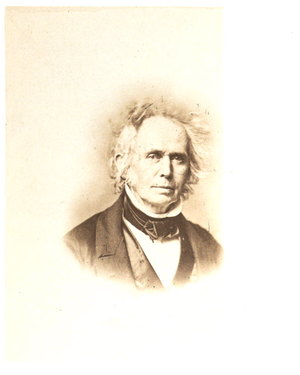
Added to collection: 2015/08/19
Earliest source: William Cranch Bond and George PHillips Bond [and Joseph Winlock]. Annals of the Astronomical Observatory of Harvard College / 1859-1860 vol. 7. Welch, Bigelow, & Co., 1872.annals7
A photo of William Cranch Bond. Bond died in 1859, while negative photography was still relatively new, but a negative of him must have existed in order to print this image, which is taken from the 1872 Annals.annals7 I'm unsure of the printing technology used here. At first I assumed it was a photolithograph, however no halftone screen is visible (although it could be a gravure method). This could also be a photo pasted into each copy, probably an albumen print, although I don't see all the edges if it's pasted - which could be a scan quality issue.
This is only the second image of him I'm aware of, the first being the painting above. All other images I've seeen are versions of one of these two original sources. The 1855 date given here is a fairly wild guess of when the photograph that it was based on was taken.
It's a fairly early example of a printed photograph, but not crazy early. Photographs in print didn't really become common until 1880s or especially 1890s, but photographs had been in print experimentally since about 1835, and to a limited degree in professional publishing since the early 1850s.
Crazy hair, right? I think some of the images derived from this original take a little artistic license, and make it even a bit more wild. I haven't had time to research his hair, but it's definitely an avenue of exploration. Was this fashionable? Unfashionable? Mad-scientist? Did people mention his hair in the published memorials of him? So many important questions remain.
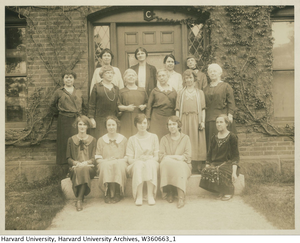
Added to collection: 2015/08/18
Earliest source: "Observatory Women [photographic group portrait, 1925]." Harvard University Archives / HUPSF Observatory (19). Harvard Libraries, olvwork360663
Harvard says the caption is "As We Were" in the upper left corner, but they must not have scanned that or it is on the back. This is an amazing photo crossing generations of women at Harvard. It's the end of the era of women computers, and the beginning of the era of women scientists.
I found a source identifying the names. Ceclia Payne's expanded autobiography.paynerecollections My guesses were all correct (I skipped five of them).
Back row:
Middle row:
Bottom row:

Added to collection: 2015/08/18
Earliest source: "[Harvard College Observatory building under contruction] 1892." Harvard University Archives / UAV 630.271 (150). Harvard Libraries, olvwork431802
Construction of the addition to the Director's Residence, 1893.annual1893
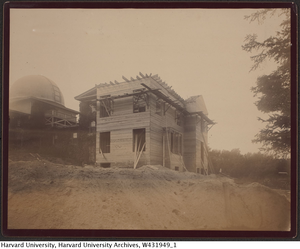
Added to collection: 2015/08/18
Earliest source: "[Harvard College Observatory, Cambridge, construction, ca. 1892]." Harvard University Archives / UAV 630.271 (297). Harvard Libraries, olvwork431949
Construction of the addition to the Director's Residence (the east wing of the Observatory), completed in 1893.annual1893 The construction began in 1892, but as of October they had only completed basic earth-moving.annual1892
This addition was made under unusual circumstances. Up until then, Director Pickering's salary was reduced, because his occupation of the residence was part of his compensation. Under a new arrangement, Pickering paid for the addition himself, and his salary continued to be reduced. But in return for footing the bill, Harvard allocated his salary reduction to the Observatory rather than the university at large.annual1892 Pickering was both an employee and benefactor of the Observatory.
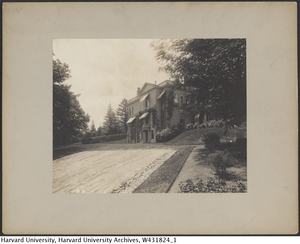
Added to collection: 2015/08/18
Earliest source: "[Observatory Residence, Cambridge, Massachusetts]." Harvard University Archives / UAV 630.271 (172). Harvard Libraries, olvwork431824
This is the director's residence after the 1893 addition, and this view is entirely of the addition. Several group photos were taken here, including the "paper doll" photo. (Or at least the 1918 AAS group photo, not yet added here.) Based on the vines, it's a least a couple of years after the addition was completed.
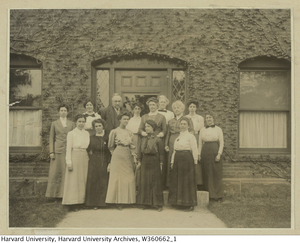
Added to collection: 2015/08/18
Earliest source: "Observatory Group [photographic group portrait, ca. 1910]." Harvard University Archives / HUPSF Observatory (14). Harvard Libraries, olvwork360662
Harvard calls this photo "Observatory Group", ca. 1910. The Internet often calls it a photo of "Pickering's Harem". I think it's from mid-1911. The lack of Williamina Fleming certainly makes it likely to be after 1911 when she passed away, and Henrietta Leavitt, also absent from the photo, was out of town until late 1911. The photo was taken in the front of the Astrophotographic Library aka, the "Brick Building", aka "Building C."
"Pickering's Harem" may be a modern sexist invention rather than a historic one. I've found no references earlier than 1976 for this phrase. On the other hand, they were much more polite about what the wrote down back then, so it may just as well be a real nickname passed down by oral tradition.
One source that DOES use that nickname, from 1982, also lists a very detailed description of the women in this photo, which I'll just quote here directly:
"At the far left of the photograph is Margaret Harwood (AB Radcliffe 1907, MA University of California 1916), who had just completed her first year as Astronomical Fellow at the Maria Mitchell Observatory. She was later appointed director there, the first woman to be appointed director of an independent observatory. Beside her in the back row is Mollie O'Reilly, a computer from 1906 to 1918. Next to Pickering is Edith Gill, a computer since 1889. Then comes Annie Jump Cannon (BA Wellesley 1884), who at that time was about halfway through classifying stellar spectra for the Henry Draper Catalogue. Behind Miss Cannon is Evelyn Leland, a computer from 1889 to 1925. Next is Florence Cushman, a computer since 1888. Behind Miss Cushman is Marion Whyte, who worked for Miss Cannon as a recorder from 1911 to 1913. At the far right of this row is Grace Brooks, a computer from 1906 to 1920. Ahead of Miss Harwood in the front row is Arville Walker (AB Radcliffe 1906), who served as assistant from 1906 until 1922. From 1922 until 1957 she held the position of secretary to Harlow Shapley, who succeeded Pickering as Director. The next woman may be Johanna Mackie, an assistant from 1903 to 1920. She received a gold medal from the American Association of Variable Star Observers (AAVSO) for discovering the first nova in the constellation of Lyra. In front of Pickering is Alta Carpenter, a computer from 1906 to 1920. Next is Mabel Gill, a computer since 1892. And finally, Ida Woods (BA Wellesley 1893), who joined the corps of women computers just after graduation. In 1920 she received the first AAVSO nova medal; by 1927, she had seven bars on it for her discoveries of novae on photographs of the Milky Way."pickeringsharem
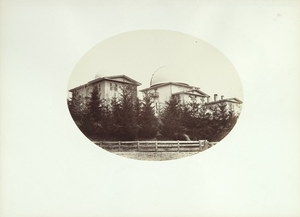
Added to collection: 2015/08/17
Image Credit: George Kendall Warren
Earliest source: "The Observatory." Harvard Art Museums. Harvard Libraries, HUAM71421
Harvard says this photo was taken by George Kendall Warren, sometime between 1861 and 1866. I strongly suspect this was taken at the same time as the other similar photo of the Observatory, also in an oval (and that photo is also Mr. Warren). The fence shown in this picture is just barely visible in the other, as fencing along the far side (from the photographer) of Concord Ave. The dome rotation seems to be identical. The trees look bigger in this picture but I think this is just the angle, having moved closer to the trees. A few of the patterns of tree branches seem to be the same between photos also.
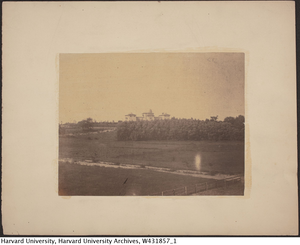
Added to collection: 2015/08/16
Earliest source: "[Observatory buildings]." Harvard University Archives / UAV 630.271 (205). Harvard Libraries, olvwork431857
Harvard says this is ca. 1910-1930. Harvard is so very wrong. The latest this can possibly be is about 1875 when they added alcoves onto the west wing, which are not apparent here.
I actually think this is from before my other earliest photo, the one from 1865. In that photo there is a fence line which I am guessing is Buckingham Street. It doesn't seem to exist here. This would make this the middle of the property labelled as "Prof. Guyot" in the 1854 map above. It also appears that some of the landscaping described in 1853 is in place here, although I can't be sure. Based on these, I sort of arbitrarily picked 1855 as a reasonable guess, but anything as early as 1850 or 1851 (when the west wing was completed) is possible.
Buckingham street was laid out in 1855cambuildings, and by 1861 appeared on maps. It's possible that the whitish streak on the left edge of the image is the beginnings of this street. Even the foreground white streak could be part of Buckingham, as it is a dogleg.
St. Peters' Parish church would be just off of the left edge of the picture. I initially conisdered the possibility that it didn't exist yet, but it was completed in 1848, and the west wing of the Observatory (the left side) wasn't completed as of 1849.academybond On the other hand, there was apparently a house built on Concord next to the church in 1859, on the nearside.cambuildings It should be visible but is not here, so I'm setting 1859 as the upper limit for this image.
Identifying the photographic process might also help here. Daguerreotypes were the mainstay for photography in the 1840s and 50s, but this is obviously not a daguerreotype. Paper-based photography was very new around this time period. This could be a calotype, which directly exposed the image on paper and was available when the Observatory was built; however its use was rare in the United States. More likely it's an albumen print, which printed on paper from glass negatives, and would probably date this photo as sometime after 1850.
WARNING: this last part is unsubstantiated wild speculation:
Photographer John Whipple independently developed his own albumen process in the mid-to-late 1840s. Whipple was a famous Boston photographer, who was associated with the Observatory around this time. He is known for taking several award-winning daguerreotypes of the moon through a telescope around 1850-1852, as well as the first photograph of a star through a telescope, which was taken using Harvard's Great Refractor with the cooperation of Bond. This photo could be an early experiment of his with various paper-based technologies.
(end wild speculation)
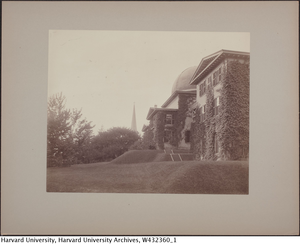
Added to collection: 2015/08/16
Earliest source: "[Harvard College Observatory, Cambridge, Massachusetts]." Harvard University Archives / UAV 630.271 (E157). Harvard Libraries, olvwork432360
A hard-to-find photo showing this angle of the building, including the director's residence in the foreground.
The key to dating this photo is the wooden balconies, added in 1880ish.harvardreport8081(missing) At the other end of the range, the residence was expanded in 1892 or 1893.
The tree on the left seems to have an odd sculpture or bench in front of it or around it. The vine growth is all new since Roosevelt's 1874 photo, but the tree in that photo has been removed (or the date on that photo is not correct).
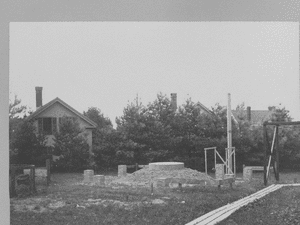
Added to collection: 2015/08/14
Image Credit: Thomas A. Fine
Construction of the dome to contain the 28-inch reflector donated by Mrs. Draper for the Draper Memorial project.
Eleven photos processed into an animated gif.
Some alternate copies of these images have penciled in dates, and based on this, the construction began before July 12, 1887 (when the platform was completed), and completed after September 1 of the same year (when the building skirt was added but the dome skirt was not in place).
A copy of the sixth image in the sequence has a date written on it, which dates the middle of the construction to July 27, 1887.olvwork432353(missing) The position of the building makes it clear that this is the dome for the 28-inch reflector, which was the second of the three large additional domes that were built.
Use/Copyright: This work is licensed under a Creative Commons Attribution 4.0 International License. 
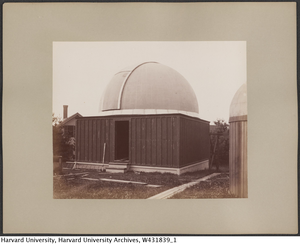
Added to collection: 2015/08/12
Earliest source: "[Telescope dome in Cambridge under construction]." Harvard University Archives / UAV 630.271 (187). Harvard Libraries, olvwork431839
Date chosen after other dated images in this sequence.
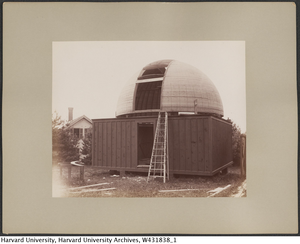
Added to collection: 2015/08/12
Earliest source: "[Telescope dome in Cambridge under construction]." Harvard University Archives / UAV 630.271 (185). Harvard Libraries, olvwork431837
[Telescope dome in Cambridge under construction]
ca. 1910-1930
Creator: Harvard College Observatory, Cambridge
Alternate copy of this image is dated August 17, 1887.olvwork432357(missing)
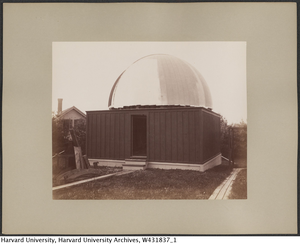
Added to collection: 2015/08/12
Earliest source: "[Telescope dome in Cambridge under construction]." Harvard University Archives / UAV 630.271 (186). Harvard Libraries, olvwork431838
Alternate copy of this image is dated September 1, 1887.olvwork432358(missing)
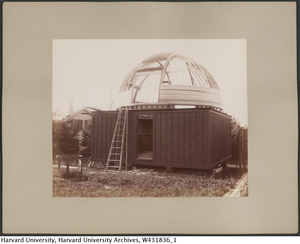
Added to collection: 2015/08/12
Earliest source: "[Telescope dome in Cambridge under construction]." Harvard University Archives / UAV 630.271 (184). Harvard Libraries, olvwork431836
Date arbitrarily picked to fit between other dated images
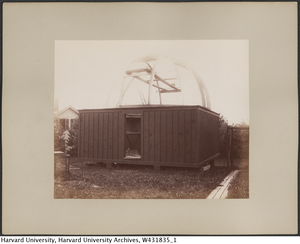
Added to collection: 2015/08/12
Earliest source: "[Telescope dome in Cambridge under construction]." Harvard University Archives / UAV 630.271 (183). Harvard Libraries, olvwork431835
Alternate copy dated August 4, 1887.olvwork432355(missing)
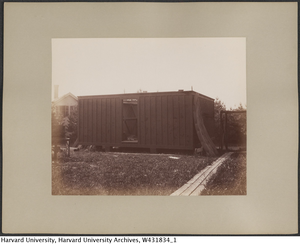
Added to collection: 2015/08/12
Earliest source: "[Building in Cambridge under construction]." Harvard University Archives / UAV 630.271 (182). Harvard Libraries, olvwork431834
Date of this photo comes from another print of this same photo, which has the date written on the border.olvwork432353(missing)
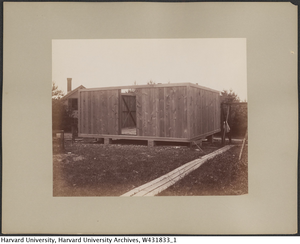
Added to collection: 2015/08/12
Earliest source: "[Building in Cambridge under construction]." Harvard University Archives / UAV 630.271 (181). Harvard Libraries, olvwork431833
Alternate copy dated July 19, 1887.olvwork432352(missing)
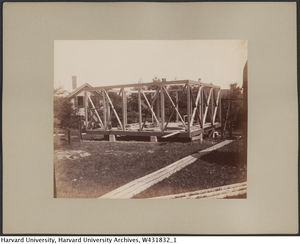
Added to collection: 2015/08/12
Earliest source: "[Building in Cambridge under construction]." Harvard University Archives / UAV 630.271 (180). Harvard Libraries, olvwork431832
Date arbitrarily picked to go between other dated images
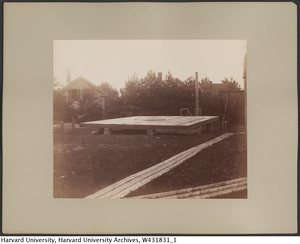
Added to collection: 2015/08/12
Earliest source: "[Building in Cambridge under construction]." Harvard University Archives / UAV 630.271 (178). Harvard Libraries, olvwork431830
Alternate copy dated July 12, 1887.olvwork432351(missing)
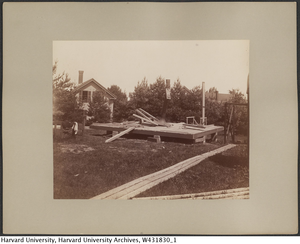
Added to collection: 2015/08/12
Earliest source: "[Platform for building in Cambride under construction]." Harvard University Archives / UAV 630.271 (179). Harvard Libraries, olvwork431831
Date arbitrarily chosen based on other dated images.

Added to collection: 2015/08/12
Earliest source: "[Building in Cambridge under construction]." Harvard University Archives / UAV 630.271 (177). Harvard Libraries, olvwork431829

Added to collection: 2015/08/10
Image Credit: George Hollingsworth
Earliest source: "Alvan Clark (1804-1887)." Harvard Portrait/Clock Collections. Harvard Libraries, HUAM311226
Alvan Clark (1804-1887), who at the time of this portrait is a portrait painter himself (shown here painting), specializing in miniatures. He is also an engraver. In the early 1840s he and his sons Alvan Graham and George Basset Clark go into telescope making business as a part-time endeavor.
Sometime shortly after the Great Refractor is installed (1847), Alvan Clark has the opportunity to use the instrument. Based on his telescope-making experience so far, he sees subtle flaws. As the story goes, this experience, along with hearing how much money could be made selling large refractors ($12,000 for Harvard's lens or about $300,000 in 2015 dollars), motivates him to go into telescope-making full time, and take on more ambitious projects. By 1862, they build the largest refractor in the world (18.5"), originally commissioned for the University of Mississippi, but sold to the University of Chicago, due to the Civil War.
The Clarks would go on to make the world's largest refractor four more times, including the 36 inch Lick refractor, and finally the 40 inch Yerkes refractor, the largest working refractor ever built.
While the relationship with Harvard is fairly tangential (and geographic, as their business was located in Cambridge for years, see the map of 1877 below), this portrait is actually currently located at the Observatory. According to Harvard, it was a gift of Mrs. Alvan Clark [which one?] to the Harvard College Observatory in 1899 (Alvan died in 1887, Alvan G. died in 1897).

Added to collection: 2015/08/10
Image Credit: William Tolman Carlton, after Justus Sustermans
Earliest source: "Galileo Galilei (1564-1642), after Justus Suttermans [sic]." Harvard Portrait/Clock Collections. Harvard Libraries, HUAM311240
I'm not generally including images for background notes that are not directly related to Harvard, however in this case this portrait is actually at Harvard, on display at the Observatory. The image is a copy of a famous portrait by Justus Sustermans, which is on display at the Uffizi Gallery in Florence Italy (where Galileo was under house arrest while sitting for the portrait in 1636).
This painting has been extensively copied, and googling for Galileo and Sustermans yields a vast array of copies of varying quality, often attributed directly to Sustermans. Harvard owns two of these copies, this one by William Toman Carlton (incorrectly attributed as "Carleton" in some sources) was given to the Observatory in 1890 after the artist's death. The other copy was previously owned by E. C. Pickering, and bequeathed to Harvard in 1919.
If you do search on google, you might notice that you find two distinct families of copies of the Susterman portrait. There are those like this one, of a disembodied head looking off to the side, and another series of him seated, eyes forward, holding a telescope. And looking even more grumpy. The original of that portrait is from Palazzo Pandolfini in Florence and is currently somewhere at the Royal Museums Greenwich. It is likely also painted by Justus Sustermans himself, perhaps around 1640 or perhaps after Galileo's death in 1642. If it is by Sustermans, it's not clear if it was based on a later sitting, or if Sustermans simply copied and expanded on his earlier work.rmgblog

Added to collection: 2015/08/07
Image Credit: Unidentified artist, after Justus Sustermans
Earliest source: "Galileo Galilei (1564-1642), copy after Justus Suttermans[sic] (1597-1681)." Harvard Portrait/Clock Collections. Harvard Libraries, HUAM299708
Copy of Sustermans' Galileo portrait, owned by Edward Pickering and bequeathed to the Observatory in 1919.
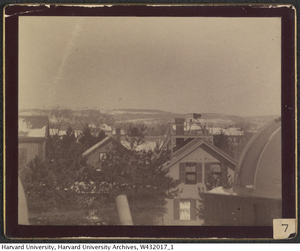
Added to collection: 2015/08/05
Earliest source: "[View of homes in Cambridge from above with telescope in foreground]." Harvard University Archives / UAV 630.271 (365). Harvard Libraries, olvwork432017
This view was taken from somewhere in the middle of the yard where several instruments were housed. The focus of the picture is the house from which many of these photos were taken. You can see an observation deck in place on the house (not yet installed in the previous image), with a camera on a tripod. You can also see spots where telegraph wires were mounted, although I can't tell how many actual lines are in place here.
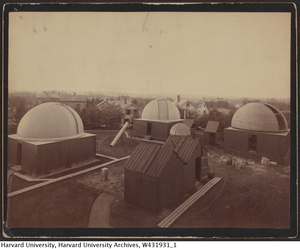
Added to collection: 2015/08/05
Earliest source: "[Harvard College Observatory, Cambridge, construction, ca. 1892]." Harvard University Archives / UAV 630.271 (279). Harvard Libraries, olvwork431931
Harvard gives this image a date of 1892, which is unlikely. The rightmost dome seems to have construction supplies in front of it, and if that's the case, this dates the image to late 1887 or early 1888, as that is when this third dome was completed for the Boyden Fund.annual1887 I also need to determine when the uncovered 15" reflector was removed and replaced with an odd shed that may be a "meridian photometer" shown in later images. The first two domes were completed in 1886annual1886 and 1887.annual1887 It can't be any later than 1892, because another photo which is prior to the construction of the brick building shows the platform already in place.
This is an unusual angle, reverse of a great many photographs. Just to the left of the dome in the center, is a house which was connected to the observatory—literally. Telegraph lines ran there. This house is the house from which a large number of later pictures were taken. Shown in more detail in a later photo (which also shows the addition of an observing platform that did not exist here).
I have no idea what those two wooden buildings in the foreground housed. But they were removed sometime between the new brick building (1892), and the brick addition (1902). Also, the building on the left was previously longer, and in this photo appears to be very recently shortened.
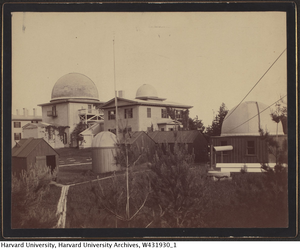
Added to collection: 2015/08/05
Earliest source: "[Harvard College Observatory, Cambridge, construction, ca. 1892]." Harvard University Archives / UAV 630.271 (278). Harvard Libraries, olvwork431930
Harvard dates this image as 1892, but that's definitely wrong. Instead of three large domes seen in later photos, there's only one. This dates the photo fairly tightly. By late 1886, the first of these domes (this one) was completed to house the 11-inch refractor donated by Mrs. Draper for an astrophotographic survey.annual1886 The next two domes (missing here) were completed sometime during 1877.annual1887 This image is taken from the same angle as many later images, except from a lower position. Perhaps from a window of the house from which later, higher photos were taken from a platform, which didn't exist at thist time.
Note that the two twin wooden sheds are not twins here, one being quite a bit longer than the other. In later photos they are the same size.
Also, the shed for the 8" telescope does not have the sliding roof supports yet. Either this was during construction, or there was a period of time perhaps when the roof sections were simply removed.
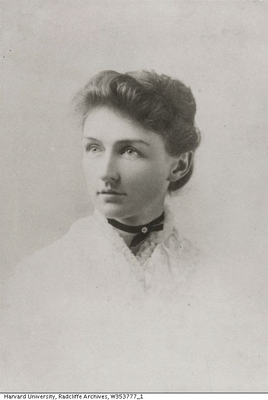
Added to collection: 2015/08/04
Earliest source: "Portrait of Annie Jump Cannon." Radcliffe College Archives / PC 70-1-2. Harvard Libraries, olvwork353777
The earliest image I've found so far of Annie Jump Cannon. This is what Harvard says: "Inscription: Verso: Miss Annie Jump Cannon of the Harvard observatory, taken while doing graduate work at Radcliffe College", and dates it 1895-1897. This would put her at about 33 years old. She had taken ten years off for lack of available work between Wellesley and Radcliffe. During this she took up photography, published a small book of photographsfootsteps, caught scarlet fever, and lost most of her hearing.wikicannon
I have a small suspicion based on her appearance in other photos that this photo may be much earlier than Harvard's 1896 date, but so far nothing to back it up.
Use/Copyright: Radcliffe College Archives: This image may not be reproduced or transmitted in any form or by any means, electronic or mechanical, without permission in writing from the Radcliffe Archives.
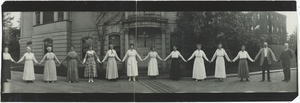
Added to collection: 2015/08/04
Earliest source: "[Observatory Staff in "paper doll" pose, (in line holding hands) panoramic photograph ca. 1918]." Harvard University Archives / UAV 630.271 (391). Harvard Libraries, olvwork432043
From left to right (primary identifications come from Harvard, who says the names were listed on the back):
I believe the correct names for two of these are "Mary H. Vann" and "Dorothy Block".jaavsoharwood Also, I think this is Mabel, not Edith Gill (or the few other labelled photos I've seen so far similarly mislabel the presumed sisters).
For the longest time I didn't know where pictures like this one were taken. This is an addition to the director's residence added in about 1893 that maybe doubled the size of the residence. The building is not curved, and the brick building to the right is the end of the astrophotographic addition, lying in the same plane. The wide angle just makes it look like a 90 degree bend.
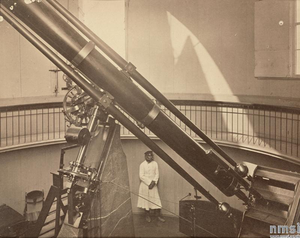
Added to collection: 2015/08/04
Earliest source: "Photograph of a large equatorial by Merz and Mahler." Science Museum Group / Collections Online - Objects. Science Museum Group, 2015.nmsipulkovo
This is the only photo I've found of the older twin to our Great Refractor - the 15" Refractor at the Pulkovo Astronomical Observatory (note that the Russian "Пулково" is also sometimes transliterated as "Pulkova" or "Pulcova"). This telescope had first light in 1839, and was the largest telescope in the world (along with ours in 1847) until 1862, when Dearborn Observatory erected an 18.5 inch. (and I'm not counting the much larger Craig telescope from 1852, because it had serious flaws that prevented effective use).
The design is similar to many other Merz and Mahler telescopes. The Naval Observatory has (or had) a 9.62" refractor that looks remarkably like a miniature version of our telescope (with a full-sized pier). There is also a similar refractor in Palermo, and I'm sure many others as well. They're all the same family but this is the only twin.
There seem to be other parallels between the two observatories. The original building design of our observatory resembles early Pulkovo perhaps more than any other observatory I've seen—a large central building, with two wings, and smaller buildings at the end of each wing. Both use triangular pediments on both the end buildings and central building. Like our observatory, Pulkovo seems to place transit instruments in the connecting structures leading out to the wings.wikipulkovo
I'm not sure who the man is in the photo. Otto Von Struve would be a logical guess, and he did have the bushy sideburns, but this man's complexion seems much darker, and I see no other photos of Struve with a mustache.
Pulkovo observatory was bombed into oblivion during World War II, but some instruments and lenses were saved, including a 30" lens from Alvan Clark & Sons from 1885 (and with that telescope Pulkovo had the largest telescope in the world for a second time). Sources seem inconsistent on whether the 15" Merz and Mahler lens was saved.wikipulkovo
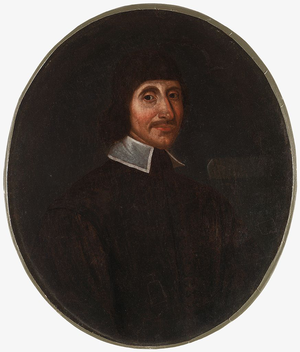
Added to collection: 2015/07/29
John Winthrop the Younger (1608-1676). He is described as America's first astronomer. Around 1660 he buys a ten foot telescope somewhere in Europe, which he brings back to Cambridge. It apparently pretty much sucks, not even being able to resolve Saturn.
So in 1663, he travels back to Europe and returns with a telescope that's smaller, but I can only assume better: "3 foote & halfe wth a concave ey-glasse".nescopes
In 1665 he uses his telescope to discover Jupiter's fifth moon. Except it turned out to be just a star in the wrong place at the wrong time.
In 1672 he gives his 3.5 foot telescope to Harvard, which seems to be Harvard's first telescope.nescopes heavensalarm
Don't be deceived by portraits of a John Winthrop with a telescope who is a well-known astronomer. That image is a painting of John Winthrop the Elder's great-great grandson, or the great grandson of this John Winthrop.
The artist for this portrait is apparently unknown, as is the year that it was painted. Still, Harvard considers it to be a valid portrait.winthropportrait
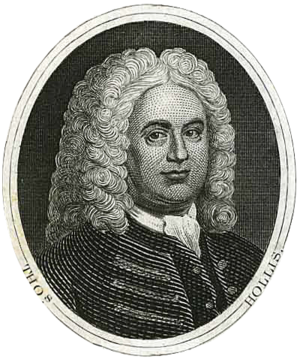
Added to collection: 2015/07/28
Earliest source: "Thomas Hollis (1659–1731)." Wikipedia. Wikipedia, 28 July 2015.wikihollis
In 1722, Thomas Hollis (1659-1731) donated a 24-foot telescope to Harvard College.winthropfirst It was housed in Massachusetts Hall. Later moved to Harvard Hall, where it, and all but one of Harvard's other telescopes were destroyed in a fire in 1764.firstfour(missing)
Thomas Hollis established the Hollis Professorship of Mathematics and Natural Philosophy in 1727, an important position for the growth of Harvard's science programs including in particular astronomy. This was the second Hollis professorship established, the first being the Hollis Professorship of Divinity, a controversial donation promoting the Baptist movement.sketchhist
This image is from an 1854 bank note from Holliston Savings Bank in Holliston Massachusetts. Holliston was named after Thomas Hollis. His image appeared on the one, two, five, and ten dollar bank notes from Holliston Bank.banknotes Apparently this is based on a painting by John Copley, which is based in turn on another painting by Giovanni Battista Cipriani in 1764, which was a copy of a painting by an unknown artist in 1723 (while Hollis was actually alive).

Added to collection: 2015/07/21
Earliest source: Edward C. Pickering. Henry Draper Memorial / Second Annual Report of the Photographic Study of Stellar Spectra vol. 2. John Wilson and Son, 1888.draperreport1888
This is one of the highest quality scans of an early image I have of the observatory. It's so good that I think it may have been a pasted-in photo. There's no signs of a halftone screen, and as far as I can tell (not an expert), no signs of photogravure techniques used around this time.
The source describes the buildings. I'll just quote it directly:
"The present location of the various instruments is shown in the Frontispiece to this Report. It represents the rear of the Harvard College Observatory, and is taken from the top of a cottage to the northwest of the main building. Of the three domes in the foreground the right-hand one contains the 11-inch photographic telescope, and the central one the 28-inch reflector. The 15-inch reflector has been attached to the tube standing between the two domes. The 8-inch telescope is mounted in the shed between the central dome and the dome to the left, which contains a 13-inch and a 10-inch photographic telescope. The east wing of the main building is to the right, and is mainly devoted to the computing work described below. The cottage from which the picture is taken contains a large dark room, in which all the photographs are developed, an adjoining room for general experimenting, a room for clerical work, and a room which may be darkened and light thrown in by a mirror ; this room is used for enlargements and other experimental work." [I think "east wing" should be "west wing".]
Note that the end there describes the "cottage" where so many photos were taken. This fills in a bit of information for me, but doesn't necessarily match other photos I have that show this "cottage" from other angles [coming soon]. It's also not consistent with a later description that says the enlarging apparatus is in a "low one story buidling with a flat roof".annals32p1

Added to collection: 2015/07/09
This is the "Portable Transit Instrument" obtained in 1870.annals8 It is shown in the West Transit room, identified by the wiring panel found in other images, and the interior window found on some building plans. It's was on the same pier as the four foot transit instrument described in the first Annals.annals8 annals1
The instrument was made for Harvard by the Pulkovo Observatory, under their "mechanician" Mr. Herbst, under the direction of Otto von Struve.annals8
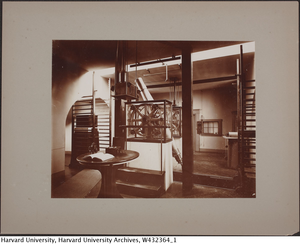
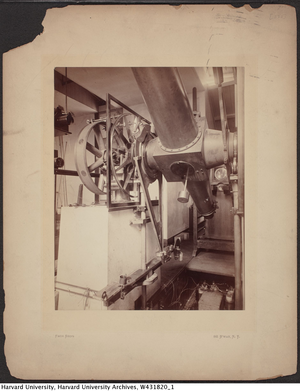
Added to collection: 2015/07/09

Added to collection: 2015/07/09
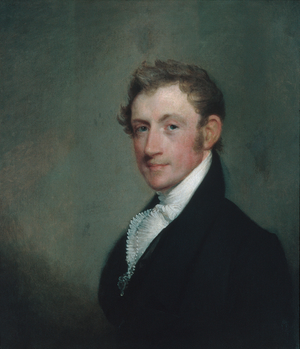
Added to collection: 2015/07/08
Image Credit: Gilbert Stuart
David Sears, 1815
Painting of philanthropist David Sears by Gilbert Stuart. Twenty eight years after this painting, David Sears will become the driving force in the donation campaign that builds Harvard Observatory and buys the Great Refractor. He makes two separate $5000 donations (about $150,000 2015 dollars).
The stone building that houses the Great Refractor is named the "Sears Tower" after him.
(Gilbert Stuart is a well-known portrait painter. His most famous work is an unfinished painting of George Washington, which was used as the basis for the one dollar bill. He did manage to complete several other portraits of George Washington, as well as John Adams, Abigail Adams, Thomas Jefferson, James Madison, James Monroe, and John Quincy Adams, who also plays a pivotal role in our little story.)

Added to collection: 2015/07/07
Image Credit: G. W. Pach
Earliest photo found so far of the Great Refractor.
Taken by G. W. Pach, of Pach Brothers photography, a well known photography firm for over a century. Their work includes Presidents and other famous people of their day like Samuel Clemens. They went into business shortly after the Civil War, by 1867. (Although another source says 1872.) Their address is printed on the image, and shows 841 Broadway, N.Y. The Pach brothers moved from this address to 935 Broadway somewhere in the range of 1888 to 1890. After which their building burned down and the lost their collection of negatives. I don't know if they reopened in New York, but the continued on in other cities.
I thought the data was further nailed down by the fact that there is no finder scope visible. In 1868, the observatory took the smaller refractor off of their west equatorial mount, and attached it as a finder telescope, to the side of the Great Refractor. However on further examination, I think that telescope is mounted, almost entirely hidden on the far side of the telescope. So now I'm much less sure of the date. [Possible that they were at 858 Broadway before about 1878 or '79]
The wood surface inside the dome is now painted white, which is too bad, because this looks amazing.
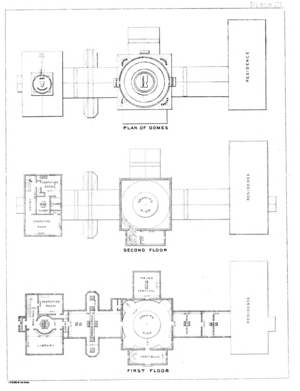
Added to collection: 2015/07/06
Earliest source: F. O. Vaille and H. A. Clark (Class of 1874). The Harvard Book / A Series of Historical, Biographical, and Descriptive Sketches vol. 1. Welch, Bigelow, and Company, 1875.harvardbook
Source for this image: [Joseph Winlock and Arthur Searle?]. Annals of the Astronomical Observatory of Harvard College vol. 8. John Wilson and Son, October 1876.annals8
These are the best floor plans I have for the observatory. Note that the Director's Residence is a black hole—I guess the rooms there were private and not our business. Incidentally, in 1867 the directors residence got running water.
One of the more significant changes is that the room next to the residence, in some earlier plans referred to as the computing room, is now the Director's room. This room also housed clocks, telegraph wiring, and other odd instruments. Rooms in the west wing had always been planned as offices or computing rooms, but this wing was unheated until sometime after 1866. With the addition of heat, and instulation, and repairs to leaky roofs and such, four additional rooms became available as computing rooms in the west wing, freeing up the director's room for whatever the director wanted to do with it. It's my belief that many of the older photographs of women computers are in one of these rooms in the west wing, as the images don't correlate to any rooms in the newer brick buildings, in particular the slightly arched ceiling.
The Prime Vertical was no longer in place, and the shutters had been sealed shut against the rain. This instrument was apparently important only for a precise determination of the observatory's position, and this having been accomplished, it was no longer needed. The room was used as a library, to house items that had previously been stored in the west transit circle rooms.
The most significant change was the newer Meridian Circle added to the west wing, replacing two previous smaller instruments. The two alcoves on either side were put in place for collimators for the new Meridian Circle.
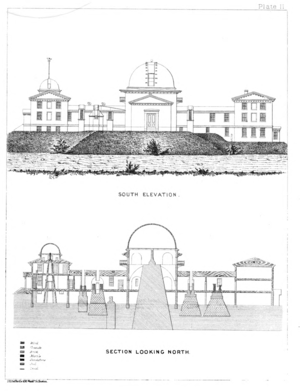
Added to collection: 2015/07/06
Earliest source: F. O. Vaille and H. A. Clark (Class of 1874). The Harvard Book / A Series of Historical, Biographical, and Descriptive Sketches vol. 1. Welch, Bigelow, and Company, 1875.harvardbook
Source for this image: [Joseph Winlock and Arthur Searle?]. Annals of the Astronomical Observatory of Harvard College vol. 8. John Wilson and Son, October 1876.annals8
Elevation of the original observatory, as modified by 1876. The left transit circle room as been expanded with alcoves on either side.
The cutaway shows the piers for the instruments in the observatory. The largest pier is for the great refractor. To it's right is a pier for one of the transit circles, and further to the right is a pier that was used for clocks and [something else].
To the left of the large pier is what the Annals describe thusly: "the deep pit indicated just to the right of the pier of the Meridian Circle shows the place of an excavation intended by Professor Bond for experiements with a standard pendulum, but found to be too damp for that purpose."
To it's left is the pier for the other transit circle. This pier appears to be new since 1844. The original plan shows two separate transit instruments in this wing, but they are equally spaced along the wing. You can still see signs of both openings in this elevation. But the new meridian circle pier is smack in the middle of the west wing. I haven't yet read abou this change.
All the to the left is the pier for the west equatorial. This is far less substantial than the other piers, apparently made of wood. After water was provided to the west wing in 1869, the pier also housed a resevoir of water for use in case of a fire. The west equatorial telescope was replaced in 1868, the original being mounted as a finder telescope on the Great Refractor. In 1870 the west equatorial dome was converted from cloth to metal.
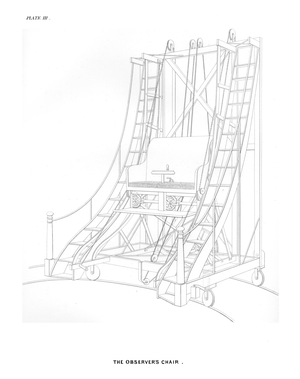
Added to collection: 2015/07/02
Earliest source: William Cranch Bond. "Description of the Observatory at Cambridge." Memoirs of the American Academy of Arts and Sciences vol. 4. Metcalf and Company, 1849.academybond
The observing chair for the Great Refractor. This chair was on wheels that set on a pair of circular tracks surrounding the refractor. The observer could use a rope and pully system to move the chair around the track. A crank in front of him was used to raise and lower the position of the seat.
This article, as well as Annals volume 1, includes additional drawings of the mechanical components of the chair that have not been included in this image database at this time.
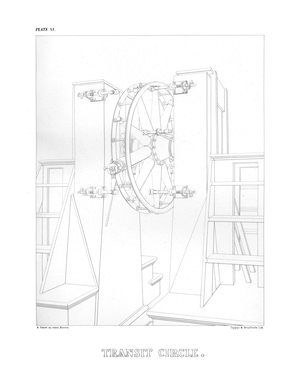
Added to collection: 2015/07/02
Earliest source: William Cranch Bond. "Description of the Observatory at Cambridge." Memoirs of the American Academy of Arts and Sciences vol. 4. Metcalf and Company, 1849.academybond
This is a drawing of the Observatory's best transit circle. It's a telescope, but it's mounted such that it can only rotate on a single axis. Most of these instruments were oriented along the meridian, and in that case were also called meridian circles. Meridian circles are used to precisely measure the timing of stars as they transit the meridian.
The Observatory possessed at least two meridian circles, as well as two "prime vertical" telescopes, which are transit circles oriented perpendicular to the meridian, rater than parallel to it.
This transit circle was mounted on one of the permanent piers built for that purpose, shown in other diagrams. It consists of a 4.5 inch refractor, made by Merz (same as the Great Rerfractor). This is mounted on a wheel four feet in diameter, consisting of a cast metal circle on each side, preciesly marked off around the perimeter in five minute increments. Eight "microscopes" mounted on the pier are used to read these markings, and a micrometer (in the eyepiece? or in the microscopes?) is used to accurately determine the direction of the telescope down to one arc-second, and estimate down to one fifth arc-second.
As early as 1844, the Observatory experimented with comparing remote transit times using telegraph connections to other observatories to determine longitudinal difference between locations. Telegraphs (which we now call the Victorian Internet) were a critical part of astronomical studies of that era. The Observatory had at least four permanent telegraph lines by 1887, and six by 1898.
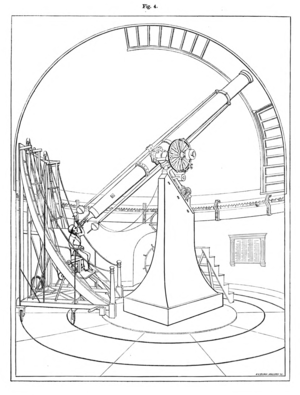
Added to collection: 2015/07/02
Earliest source: William Cranch Bond. Annals of the Astronomical Observatory of Harvard College / History and Description of the Astronomical Observatory of Harvard College vol. 1. Metcalf and Company, 1856.annals1
Another drawing based on the Nutting/Sonrel lithograph.
Inscribed at the bottom with "Kilburn-Mallory SC". SC is short for sculpsit, latin for "carved this" (because this is an engraving).

Added to collection: 2015/07/02
Image Credit: Electro-recording Apparatus
Earliest source: William Cranch Bond. Annals of the Astronomical Observatory of Harvard College / History and Description of the Astronomical Observatory of Harvard College vol. 1. Metcalf and Company, 1856.annals1
"Electro-recording apparatus"
As described in the annals, this device uses "electro-magnetism" and "galvanic current". It is electrically wired to the observatory clock, and to switches placed at all of the major instruemnts. It records clock ticks in spirals on a paper cylinder, which is pulley driven. It also records signals from any of the instruments. So for example, when a transit is being measured, the precise instant a star transits the meridian, the observer will press a switch which will record an event on the cylinder.
Here's my understanding at this time. The precise timing of star transits on the meridian circle is used to determine the star's exact position at the meridan, and hence in the sky. The prime vertical (transit circle) instrument can then be used to measure the exact time a star crosses the prime vertical circle (the vertical circle which is perpendicular to the meridian circle). Based on the star's known position, and this time, the observatory was able to make precise measurements of its latitude, which by 1856 was 42° 22' 48.1", which at the time was the most accurately measured latitude on Earth.
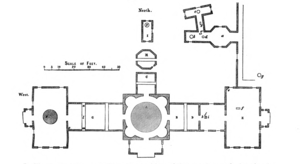
Added to collection: 2015/06/30
Earliest source: William Cranch Bond. Annals of the Astronomical Observatory of Harvard College / History and Description of the Astronomical Observatory of Harvard College vol. 1. Metcalf and Company, 1856.annals1
Similar diagram to the 1848 verson, with different labels.

Added to collection: 2015/06/30
Earliest source: [Joseph Winlock and Arthur Searle?]. Annals of the Astronomical Observatory of Harvard College vol. 8. John Wilson and Son, October 1876.annals8
Plan of Observatory Grounds, and basic building plan. The west wing of the main observatory has had "alcoves added to receive the collimators of the Meridian Circle". The "Magnetic Observatory" building has been completed since the last plan we have on file (1845, above). Glimpses of this building are visible in later photos from 1887 and 1888. At first I thought this might be the location of the photographic enlarging room, as it closely matches the description in Annals32.annals32p1 However the 1888 Draper Report indicates the enlarging room was in a cottage where many photos of the Observatory were taken, and where the telegraph lines ran.draperreport1888 This is apparently not the building shown in the corner here with telegraph lines going to it, as the angles don't line up. with the photos. That cottage seems to be off of the property, on Madison Street (although that is now our property, as a parking lot).
The 1876 report where this plan was included indicates that some of the smaller buildings have been torn down. The building previously called a smaller prime veritcal room is already missing in this newer diagram. Between 1869 and 1876, the report further states that the unlabelled building north of the Great Rerfractor (G, East Equatorial) and I Prime vertical has been removed. Also removed are the set of odd shaped rooms labelled S here jutting out from R the Magnetic Observatory.
Note that the 1876 report refers to a building diagram in the 1855 report, which is identical in form to the one I have above from 1845, but with different lettering. The 1876 report also includes floor-by-floor building plans, lablelled with words rather than letters (included just above or below this one).
The telegraph lines go to a building where an observation deck was constructed, and many later photos were taken there.
Note that the grounds seem bigger in 1876 than in 1845. The Annals are a bit confusing on this point. If I interpret things correctly, the additional space northwest of the driveway used to belong to W.C. Bond (the father or the deceased son), and was purchased by the University form Selina Bond (by Director Joseph Winlock) in 1869, but by 1876, no changes to the grounds had been made. This plot of land would later hold Tennis courts which remain there (in updated form) today.
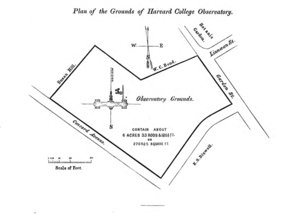
Added to collection: 2015/06/30
Earliest source: William Cranch Bond. Annals of the Astronomical Observatory of Harvard College / History and Description of the Astronomical Observatory of Harvard College vol. 1. Metcalf and Company, 1856.annals1
Earliest plan (found so far) of the observatory property, one year after the buildings were (mostly) completed. Other sources date this diagram to 1845
Still several areas for further research here.
When was Bond Street to the south named? Perhaps already, as it was likely done as a memorial to the son who died in 1841, rather than the director.
Was Madison Street (to the northeast, where it says "Susan Hill") already there? Other maps are unclear, the lack of a street doesn't mean it wasn't there, and one map I've seen has two parallel streets there before Huron (which was then Wyeth).
Was this before or after a land purchase from Susan Hill? Did they buy only part?
What was the old property line between Craigie/Foster heirs, and the other seller (Hill?)?
Where's the rest of the acreage? In the attached notes, it says that the university purchased 484,605 square feet from the Foster heirs (Craigie's sisters' descendants). But the drawn property is only 270,525 square feet. Also, it says that 62,271 square feet were purchased from Miss Hill. And elsewhere Harvard records indicate that part of the land they bought was then resold, for $600 (out of a total land purchase cost of $8288.85 according to this Annals).
When did the University buy additional property lablelled here as "W.C. Bond" (and was that the father or son?). A portion here was later purchased by Harvard from Selina Bond, the director's daughter, to expand the Observatory grounds to the modern borders.
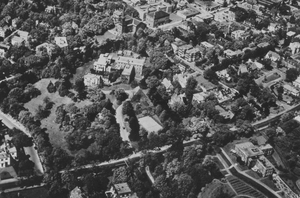
Added to collection: 2015/06/30
An Aerial view of the Observatory, unknown date. The newest plate stacks addition from 1931 is visible, but the 1954 replacement of the original frame buildings surrounding the Sears Tower has not yet happened. The 28" reflector dome (northwest corner) is missing - the structure still exists but the top is now a platform. The 8" refractor shed and the 12" refractor dome are still in place.
The building in the lower right is Kittridge Hall, home of the Harvard Press.
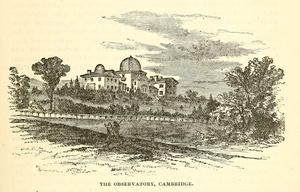
Added to collection: 2015/06/29
Earliest source: Elias Nason. A Gazetteer of the State of Massachusetts. B. B. Russell, 1874.gazetteer
Another woodcut of the Observatory.
Based on the low tree growth and the lack of the added alcoves on the transit circle in the west wing, this woodcut is probably an older image, or at least based on an older image.
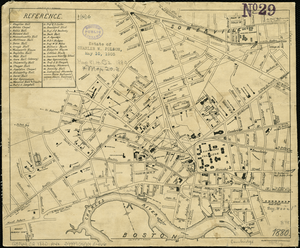
Added to collection: 2015/06/25
An 1880 map of the Harvard region of Cambridge. (The date comes from the Boston Public Library, and is handwritten on the document in pencil in at least three places, but I don't see it printed anywhere).
Note that the observatory has north-south, and east-west lines drawn through it. Being an observatory, it is aligned with the earth, rather than the adjacent roads. And in it's first years, the prime vertical instrument was used to calculate it's lattitude more accurately than any other place on the planet. Following these lines to the edges, you'll find both the longitude and latitude of the observatory as it was known then, in degrees, minutes, seconds, and tenths of seconds: 42° 22' 48.3" N by 71° 7' 44.7" .(Although when I plug this into Google Maps, it comes up a few hundred feet off. Maybe Google maps needs a bit of calibration?)
To the north of the Observatory is the house of L. Trouvelot, and a property marked "Trouvelot's Observatory". Etienne Leopold Trouvelot was one of the best known science illustrators working in astronomy at this time. He worked at the Observatory from 1872 until 1882, when he returned from France. He was especially known for his drawings of the sun and sunspots. I had no idea he had his own observatory, seeing it on the map is the first I've heard of it.
Prior to drawing astronomical subjects, he had been an amateur entomologist, and in 1868 he accidentally introduced Gypsy Moths into the United States, an infestation that is still with us, and still a significant problem today.
Right next to the Observatory along Madison Street is the house of Arthur Searle, Assistant director under Joseph Winlock when he died in 1875, and interim director until Edward Pickering was appointed in 1877. Arthur Searle may have been the one that hired the first female computer, Anna Winlock, who needed to provide for her family after her father's death. This property is now a part of the Observatory, and I'm not sure when that occcurred. In the original plan of the Observatory this property was marked as owned by Susan Hill.
Along Kirkland Street (heading east from Cambridge Commons and Harvard Square) you can also find the home of Professor Joseph Lovering. I've come across a great story about him, which I'll add when I get to doing photos of him.
On Shepard Street, very close the the due-east line from the observatory, the house of "W. A. Rogers" is shown. William Rogers worked together with Anna Winlock (first female computer) on a catalogue of polar stars, which Anna Winlock completed after his death.
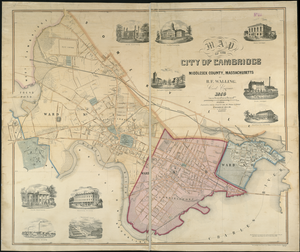
Added to collection: 2015/06/25
Image Credit: H. F. Walling
Map of Cambridge from 1854. A rough outline of the observatory is shown on the grounds, along with a drive which used to connect Garden Street to Concord Avenue. Bond Street is not labelled with a name. Farther up Garden Street, we can see a home labelled "G. P. Bond". This would be George Phillip Bond, future director and one of the son of the director at that time, William Cranch Bond (who would have been living in the residence on Observatory property).
I've seen indications elsewhere that Bond St. was named in 1842, which seems off. However one of the director's sons, William Cranch Jr., died in 1842, and it may be that the street was named after him.
It doesn't show the borders of the Observatory property, but Harvard did not own all the way to Huron Ave (called Vassal Lane on this map). The southwest part of the property extended to what we now call Madison Street (not shown, but I've seen it in an 1852 map), but the northwest did not. The Observatory later purchased part of the northwest corner from Selina Bond (which seems suspicious to me, but I haven't looked into it yet).
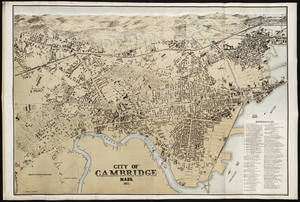
Added to collection: 2015/06/25
An 1877 map of Cambridge, notable because of all the hand drawn buildings of Cambridge. The Observatory is shown with both wings, with the Prime Vertical building to the north, and with the additional space completed to the North West. It also shows several smaller buildings to the west, but I believe these are houses off of Madison, as they don't correspond to the instruments that the Observatory had in place at the time. Substantial tree growth is shown in what was earlier mostly cleared fields. The Botanical Garden used Observatory space as a nursery at some point, although I'm not sure how much this contributed to the landscaping.
If you inspect the bottom right portion of the map, and follow the bridge up from the bottom, taking the left branch, this will put you on Brookline Steet. As you go up you will first cross Leverett St. and then come to Henry Street. There are several buildings drawn in below and to the right of Brookline and Henry. This is the Alvan Clark & Sons telescope company. For more details, see the 1840 portrait of Alvan Clark above.
The same year this map was made, Alvan Clark used a 26-inch telescope he'd made for the University of Virginia to confirm the discovery of Mars' moons, made by the other 26-inch telescope at the Naval Observatory, which Clark & Sons had delivered several years earlier.academy12 mechanic26
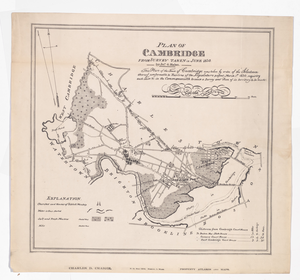
Added to collection: 2015/06/25
An 1830 map of Cambridge. The area the observatory will occupy is across the street from the Botanical Garden (for which Garden Street was named) and to the south. None of the cross streets from Graden to Concord are show except for what is now Huron. I'm assuming they were not actually there at the time. The structure on Summerhouse Hill would be in this area, but is not shown.
It's possible the summer house was already gone at this point. When the Observatory was built in 1844, it was apparently a surprise discovery that they were building on the old foundation of the summer house (on the ice-storage basement).
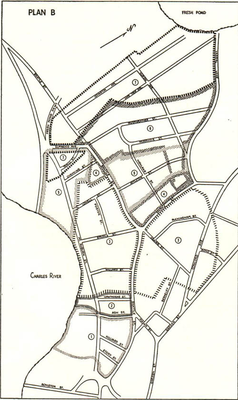
Added to collection: 2015/06/25
Earliest source: William L. Payson. "Notes on Some Tory Row Land Titles." The Proceedings of the Cambridge Historical Society vol. 37. 29 January 1957.toryrow
This map is actually from 1957 (I think), but it documents the Tory Row estates in the pre-Revolutionary War period. The area marked as number 3 (both sides of brattle with the lighter broken-line boundaries) is the estate of John Vassal. The observatory grounds are all the way to the right above Bond St. (the rightmost street with a label on it). According to this source, which admits to not being entirely thorough, the Vassal estate covered one corner of the Summer-house hill, eventually the obseratory. I think the line here would include the summit, where the Summer House stood, but it's not entirely clear.
Note that the streets are as they existed in 1957, not 1775. I don't think Bond Street existed at all until the Observatory was built, and if it did, would have had a different name. Likewise, Craigie Street wouldn't have had that name.
Vasall was loyal to the crown, and chose the wrong side when the Revolutionary War started. He fled and the Commonwealth seized the property. George Washington used his home as his headquarters for a year in 1775-76. The Commonwealth eventually sold the estate, and after changing hands a couple of times, it was sold to pharmacist and investor, Andrew Craigie. Craigie was both unwise and corrupt in his investments, and by the end of his life wouldn't leave his home for fear of arrest. He died of a stroke in 1819. His wife Elizabeth rented out rooms to cover his debt, until her death in 1841. Harvard purchased the Obsevatory grounds just a few months later from Craigie's heirs, grandchildren of his sisters (both from the same husband, Bossenger Foster (serially)).
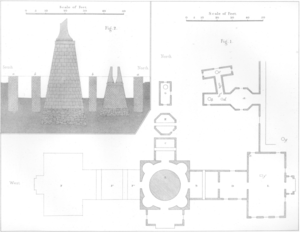
Added to collection: 2015/06/23
Earliest source: William Cranch Bond. "Description of the Observatory at Cambridge." Memoirs of the American Academy of Arts and Sciences vol. 4. Metcalf and Company, 1849.academybond
Earliest found plan of the observatory so far. Here are the descriptions found in this book:
Plate I., Fig. 1, is a ground plan of the principal buidings and of those appropriated to magnetc and meteorological purposes; at
A is the equatorial room and pier.
B, The transit-circle room.
C, The prime-vertical apartment.
In the smaller buildings,
a. The situation of the four-foot meridian-transit instrument.
b, The horizontal-force magnetometer.
c. The declination magnetometer.
b' and c', The reading telescopes of the magnetometers.
d, The small altitude and azimuth instrument.
In the construction of the buildings which protect the magnetic instruments, iron has been entirely excluded.
The wires connecting with a system of magnetic-telegraph lines, extending to most of the principal cities of the United States, are brought into the building containing the four-foot transit instrument, at a.
e is the situation of the standard barometer, made by Newman.
f, The transit or sidereal clock.
g, The deep well, for temperature of the earth at different depths below the surface.
G is a building used for miscellaneous purposes, chiefly for observation of the magnetic inclination; no iron was used in its construction.
H, The smaller prime-vertical room.
D, The computing room.
E, The observer's dwelling-house.
The western wing, indicated by dotted lines at F, F', F'', is not yet built.
Plate I., Fig. 2, is a north and south section of the foundations of the walls of the equatorial and prime-vertical rooms, and of their respective piers; at a a are the foundatons of the outer walls, and at b b those of the inner walls; the latter support the dome.
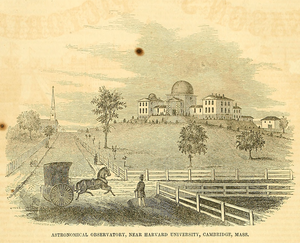
Added to collection: 2015/06/22
Image Credit: Richard P. Mallory; Worcester and Co.
Earliest source: Gleason's Pictorial Drawing Room Companion. 1851.gleason
This is one of two nearly identical woodcuts showing this view, from the corner of Concord Ave and Bond St. This version has been reproduced into the modern era, with a colorized version appearing on some Harvard Observatory websites currently. The other version from Sears' book is below.
This view includes the St. Peter's Church on the left, which is still there today, and was completed in 1848, and dedicated in May 1849. This was about one year after the Observatory installed the Great Refractor.
According to the Harvard Library Bulletin (Volume III, beginning around pg. 58), there are two slightly different versions of this image, due to a reprint of the early issues in 1853 to fill demand. This is apparently from the reprint. I've seen copies that are the original, and can't see any difference between the versions, but unfortunately I haven't found any good copies, just monochromatic pixelated versions.
The Libary also suggests that all of these are based on a drawing they had acquired recently (as of 1949 I think) but I can't currently find any such drawing in their collection.
Image credit company name is found in lower left corner. The artists name appears on fencework in the foreground ("Mallory del").
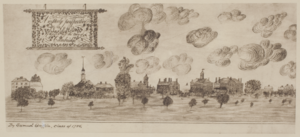
Image Credit: Samuel Griffin
A Sketch from 1784 of Harvard, facing West. Just to the right of the center of the image is Massachusetts Hall, to its right in the distance (before the next adjacent building which is Harvard Hall), is a small structure on a hill. This is Summerhouse Hill, future site of the Observatory.
Samuel Griffin may have included this drawing as part of his mathematical thesis. It was displayed at an exhibition in April 1784.
Griffin later moved to Virginia, where he was killed by one of his wife's slaves in 1812.
At this point, Summerhouse Hill was part of the John Vassal estate. Vassal's home is now a national park site, the Longfellow House on Brattle Street. Vassal abandoned his property when the Revolutionary War broke out, because he was loyal to the King.
(Most of the information here comes from the Harvard Library Bulletin Volume 1 Number 3, Views of Harvard to 1860, Part III).
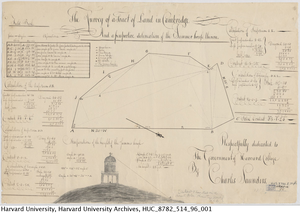
Image Credit: Charles Saunders
Summerhouse hill, before it was Observatory Hill and before the Observatory existed at all. At this point it was owned by Andrew Craigie who's heirs would eventually sell it to the observatory.
Andrew Craigie, in addition to being a corrupt politician, was also a great innovator. He was one of the earliest people to build a greenhouse, even though it was considered unnatural by many at the time. He was also an early adopter of the concept of an ice-house. And it was built underneath his summerhouse, where early excavations for the Observatory would find signs of its existence.
From Charles Saunders' mathematical thesis.
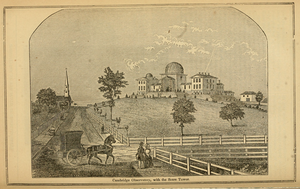
Added to collection: 2015/06/22
Image Credit: S.F. Baker SC.
Earliest source: Robert Sears. A Pictorial Description of the United States. 1852.pictorialus
This is one of two nearly identical woodcuts showing this view, from the corner of Concord Ave and Bond St. The other is above, from Gleason's Pictorial Drawing Room Companion, volume I.
According to the Harvard Library Bulletin (Volume III, beginning around pg. 58), this image appears in the the 1852 edition, though I haven't personally seen that. The closest I've seen is the torn edge of this missing page (pg. 71) in online scans of the 1854 edition. The Bulletin suggests that the "Sketches of Boston" woodcut may have used the same, reworked blocks. Given that the view is reduced in that image, and the clouds are different, I think one of the two views that shows both Concord and Bond Avenues must be the original.
Image credit is found in lower left corner.
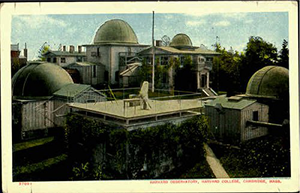
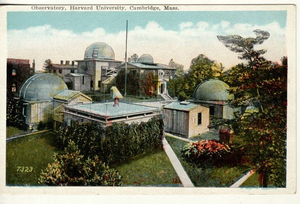
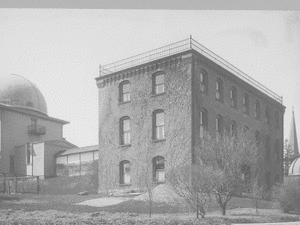
Added to collection: 2015/06/19
Image Credit: Thomas A. Fine
Earliest source:
An animated gif built from a selection of related images.
Use/Copyright: This work is licensed under a Creative Commons Attribution 4.0 International License. 

Added to collection: 2015/06/19
Image Credit: Thomas A. Fine
Earliest source:
An slow version of the animated gif built from a selection of images above.
Use/Copyright: This work is licensed under a Creative Commons Attribution 4.0 International License. 

Added to collection: 2015/06/17

Added to collection: 2015/06/17

Added to collection: 2015/06/17

Added to collection: 2015/06/17

Added to collection: 2015/06/17

Added to collection: 2015/06/17

Added to collection: 2015/06/17

Added to collection: 2015/06/17

Added to collection: 2015/06/17

Added to collection: 2015/06/17

Added to collection: 2015/06/17

Added to collection: 2015/06/17

Added to collection: 2015/06/17

Added to collection: 2015/06/17

Added to collection: 2015/06/17

Added to collection: 2015/06/17

Added to collection: 2015/06/17
First photo in a series of photos taken from approximately the same location, showing the construction of the addtion of the Astrophotographic Library to the original astrophotographic building. The first part was built in 1892-1893. The addition began in April 1902, and was mostly complete on the outside by mid June.

Added to collection: 2015/06/17

Added to collection: 2015/06/17

Added to collection: 2015/06/17

Added to collection: 2015/06/17
Original from Harvard is mirrored, this image has been flipped to fix it.
If you look above the leftmost dome, you'll see a small rooftop. I think this is the Bruce doublet building. It was housed at Harvard in 1893-95 before being moved to peru, and photographs show that it was in a small brick building with an angled roof. I haven't found it in any other wider photos of the Observatory grounds, so I can only assume this is it.
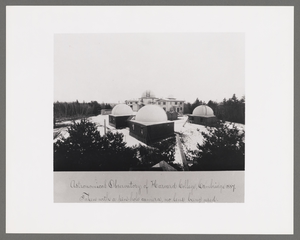
Added to collection: 2015/06/17
Earliest source: "Astronomical observatory of Harvard College, Cambridge, 1887." Harvard College Observatory Library / 6610-18. Harvard Libraries, olvwork422686
Winter photo via pinhole camera. Only four telegraph lines. The picture is labelled 1887; it's the end rather than the beginning because only one dome existed in the beginning of 1887. I picked December, but it could be any early snowfall in late 1887.
Caption reads:
Astronomical Observatory of Harvard College, Cambridge, 1887.
Taken with a pin-hole camera, no lens being used.

Added to collection: 2015/06/17
Image Credit: William Notman & Son
Harvard says this is from the Theodore Roosevelt Collection, a photo from his youth. Harvard attributes this to a professional photographer, but wow this is an awkward composition. IMHO. Maybe Roosevelt took it and Notman & Son just printed it?
[This photo might be under copyright protection (sigh). Because things are copyrighted based on their publication date, not when they were produced. Personally I take issue with exactly who holds the copyright at that point, and whether copyright still serves any reasonable purpose. Also, given that Harvard attributes this to a professional photographer, I suspect that this photograph WAS in fact published, and a copy simply ended up in this collection. Although if this photo was taken by a Roosevelt and merely developed by the professional photographer listed, and then given to someone else, then in that case it was never actually published until the collection was donated to Harvard.]

Added to collection: 2015/06/17
A very early photo of the observatory, 1865. The date comes from Harvard's image archive, but they don't say how they arrived at it. It's possible it was written on the reverse of the image. Based on tree heights, it seems reasonable (but I'm not pretending to be an expert on tree growth).
At first this fence line didn't make sense to me. But I think the near fence is along Buckingham Street (or perhaps a driveway that predates Buckingham), and the rest of the fence (with the pickets) is along Concord Ave, on the side closer to the photographer. A bit of fence on the opposite side of Concord is also just visible. See 1877 map.
I think the regularly spaced pine trees shown here that run parallel to Concord Avenue may still exist today (at least most of them). This area along Concord is now an unlandscaped wooded area. Hidden among the other trees are several very tall pine trees, which are almost perfectly in a line, and fairly evenly spaced, running parallel to Concord. They begin northwest of the observatory and continue southeast almost until the Sears Tower. These might be the same trees described by Bond in 1853:
"The only change that has been made in the disposition of the grounds has been the closing of the entrance from Concord Avenue, by forming embankments and planting trees next to the road, and making a carriage drive or turn on the eastern side. This has effectually put a stop to what was found to be an incrasing inconvenience; namely, the appopriation of this entrance by the public as a common thoroughfare for carriages as well as foot-passengers."annals1
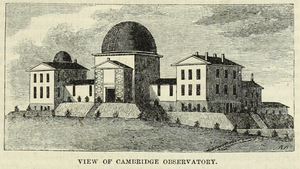
Earliest source: Elias Loomis. "Astronomical Observatories in the United States." Harper's New Monthly Magazine vol. 13 no. 73. June 1856.observusharpers
Similar to other early observatory drawings. Looks like a re-working of the illustration from Sketches of Boston. This image is signed "AA".

Added to collection: 2015/06/12
Earliest source: Daniel W. Baker. History of the Harvard College Observatory During the Period 1840-1890. 1890.baker90
This is the same angle as many later images, and probably based on a photo.
Building C (the Astrophotographic Building) is notably absent, as are some of the instruments in later photos of the foreground area. There are only four telegraph lines on the front corner of the nearest dome, where later photographs show six.
The image is signed(?) as "Photo Elec Co; Boston".

Added to collection: 2015/06/12
Image Credit: L. Grant
Earliest source: Daniel W. Baker. History of the Harvard College Observatory During the Period 1840-1890. 1890.baker90
Not many images from this timeframe, and no others I know of from this particular angle. More tree growth than in the 1850s images.
Preface to this book by Edward C. Pickering, September 13, 1890

Added to collection: 2015/06/12
Earliest source: Edward C. Pickering. "The Astronomical Observatory." Harvard Alumni Bulletin vol. 17 no. 23. Harvard Bulletin, Inc. Boston, Mass., 10 March 1915.alumni1915
This article was published in 1915, but is clearly an older photo of the observatory. It is almost identical to an image above, except that image shows three intsruments open which are all closed here. Other than that they appear identical. (exact same angle, same instruments, awning on the original building, pipe on the roof of original building, domes facing the same directions, even the slightly open curtains in builing C appear the same).
This image is also found in "The Henry Draper Memorial" by Annie J. Cannon from The Journal of the Royal Astronomical Society of Canada, v. 9. 1915.
The image found there identifies many of the instruments:
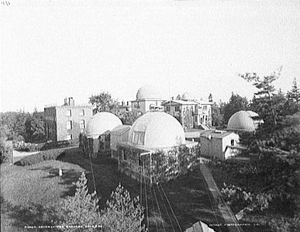
Added to collection: 2015/06/12
A slightly wider angle than some of the other images
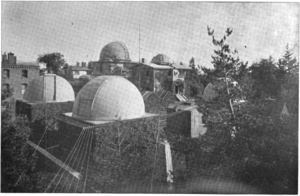
Earliest source: Harriet Richardson Donaghe. "Photographic Flashes from Harvard Observatory." Popular Astronomy vol. 6 no. 9. November 1898.popularastro6
This image dated to before November of 1898. The railing on the astrophotographic building has been added. Also a pipe of some sort appears on the small dome of the original building. But the two twin buildings whose roofs form an "M" is still there close to the original building.

Added to collection: 2015/06/12
Earliest source: George C. Comstock. A Textbook of Astronomy. 1901?.comstocktextbook
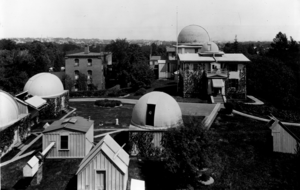
Added to collection: 2015/06/11
The twin "M" buildings near the original building have been removed.
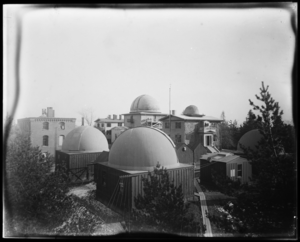
Added to collection: 2015/06/11
Earliest source:
The building farthest to the left is the Astrophotographic Building or Astrophotographic Museum (later called the "brick building", now simply called "Building C"). It was built in 1892, and expanded in 1902. This dates the building in that time range, and the lack of a railing found on the building in later photographs (but still prior to the addition) puts it towards the early end of that range. Based on photos with fresh landscaping which include the railing, I assume this was done almost immediately, which is how I estimated the month (and the fact that there's still hints of snow on the ground).
This photo also lacks the covered/enclosed walkway from the great refractor to the astrophotographic building found in later pictures.
Note in the enlarged image all the telegraph wires. Observatories were in quick contact with each other to confirm observations. Telegraphs were also used for synchronized observing, and Harvard experimented with equipment for recording synchronized clock times via telegraph.
The version of this image stored at Harvard was reversed left-to-right. The copies here have been corrected.

From a Postcard
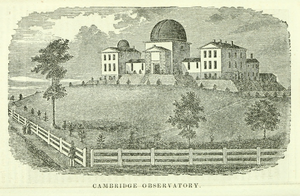
Added to collection: 2015/06/10
Earliest source: Isaac Smith Homans. Sketches of Boston, past and present / and of some few places in its vicinity. Phillips, Sampson, and Company, 1851.sketches
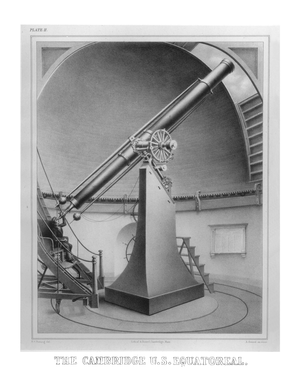
Added to collection: 2015/06/10
Image Credit: B.F. Nutting, A. Sonrel
Earliest source: William Cranch Bond. "Description of the Observatory at Cambridge." Memoirs of the American Academy of Arts and Sciences vol. 4. Metcalf and Company, 1849.academybond
An impressive lithograph of the Great Refractor (called the Grand Refractor in some early documents, and in this case, "The Cambridge U.S. Equatoreal" [sic]. The image linked here is HUGE and detailed, and suitable for significant cropping or zooming.
One thing that seems to be missing from this image is a finder telescope. The current finder telescope may be a telescope that used to be mounted in a dome on the west wing of the original observatory. According to "Annals" volume 8, the west wing equatorial was mounted onto the east equatorial in 1868, and I assume this is the same telescope mounted there today. It's unclear if there was originally a smaller finder, but if you look closely at this lithograph, there is something that could be a small finder telescope just above the eyepiece shaft of the main telescope.
The image is credited at the bottom to both B. F. Nutting and A. Sonrel. Nutting was a well-known Boston artist, and Sonrel was a well-known artist, lithographer, and photographer. The image is credited this way:
B. F. Nutting del. Lith of A. Sonrel, Cambridge, Mass. A. Sonrel on stone.
In practice, I'm not sure what this means. "del." is an abbreviation of delineavit, which is latin for (more or less) "drew this". But lithography was a process of drawing directly on stone (followed by several chemical treatments which caused ink to bind only where the artist had drawn). I'm not aware of any method for transferring an image from paper to stone. Nutting had done some of his own lithographs, but if he had done all the drawing, would Sonrel really be credited just for carrying out the chemical processing or printing reproduction? This seems unlikely. Either Nutting started it directly on the stone and Sonrel completed it, or Nutting drew a paper version, which Sonrel completely reproduced by hand on the stone. To me the crediting suggests the latter.
This image was copied repeatedly by other artists to make engravings and etchings of the telescope for various other publications.
The plaque on the wall is a list of donors that is still in place today, in the same position with respect to the pier. The sky is depicted as daytime and cloudy, so what the heck is the observer looking at?
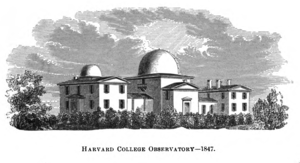
Added to collection: 2015/06/10
Image Credit: unknown
Earliest source: William Cranch Bond. Annals of the Astronomical Observatory of Harvard College / History and Description of the Astronomical Observatory of Harvard College vol. 1. Metcalf and Company, 1856.annals1
One of the oldest engravings of the Observatory, in a view that seems to be from Concord Avenue, from this location the observatory would be higher up. Possibly this was rendered before construction was complete, although the earliest version I have found (so far) is 1856. Note that the number of windows shown. The building wings each had two windows on each flor, and a third sort of vent or covered window. The three-window versions more closely match what is shown on plans, while the two window version shown here looks more like the early photographs. The document I sourced gives 1947 as the year of the image, but I haven't been able to find this image (or another which it might be based on) in any earlier sources.

Added to collection: 2015/06/10
Earliest source: Isaac Smith Homans. Sketches of Boston, past and present / and of some few places in its vicinity. Phillips, Sampson, and Company, 1851.sketches
An etching (or engraving, I'm no expert) based on the Nutting/Sonrel lithograph above (or both images were based on an additional unkown source).
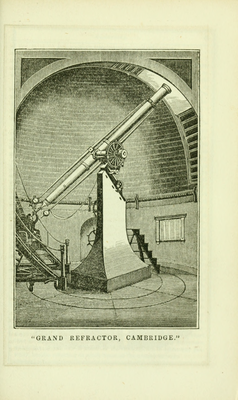
Earliest source: Isaac Smith Homans. Sketches of Boston, past and present / and of some few places in its vicinity. Phillips, Sampson, and Company, 1851.sketches
Alternate copy of the Sketches of Boston Grand Refractor image.
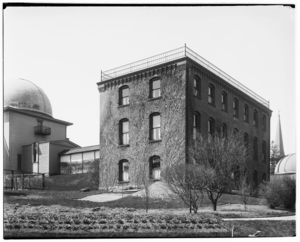
Added to collection: 2015/06/10
"The Harvard Astrophotographic Museum". Also known to me as my office building. The building was expanded in 1902, as documented in photos that will be added below. This photo is part of that series, and appears to be a different print of the first image of the series used to make the animation below. The building was mostly completed in 1892.annual1892 crimson18921019(missing) It was completed in 1893 and the plates were transferred.annual1893
Apparently this plate transfer involved loading the plates (which are heavy, fragile glass) into crates, 100 plates at a time, and letting them run downhill on a rope and pulley system from a window in the west wing of the old observatory and safely into the new building.annual1893
 Fine's Home
Fine's Home